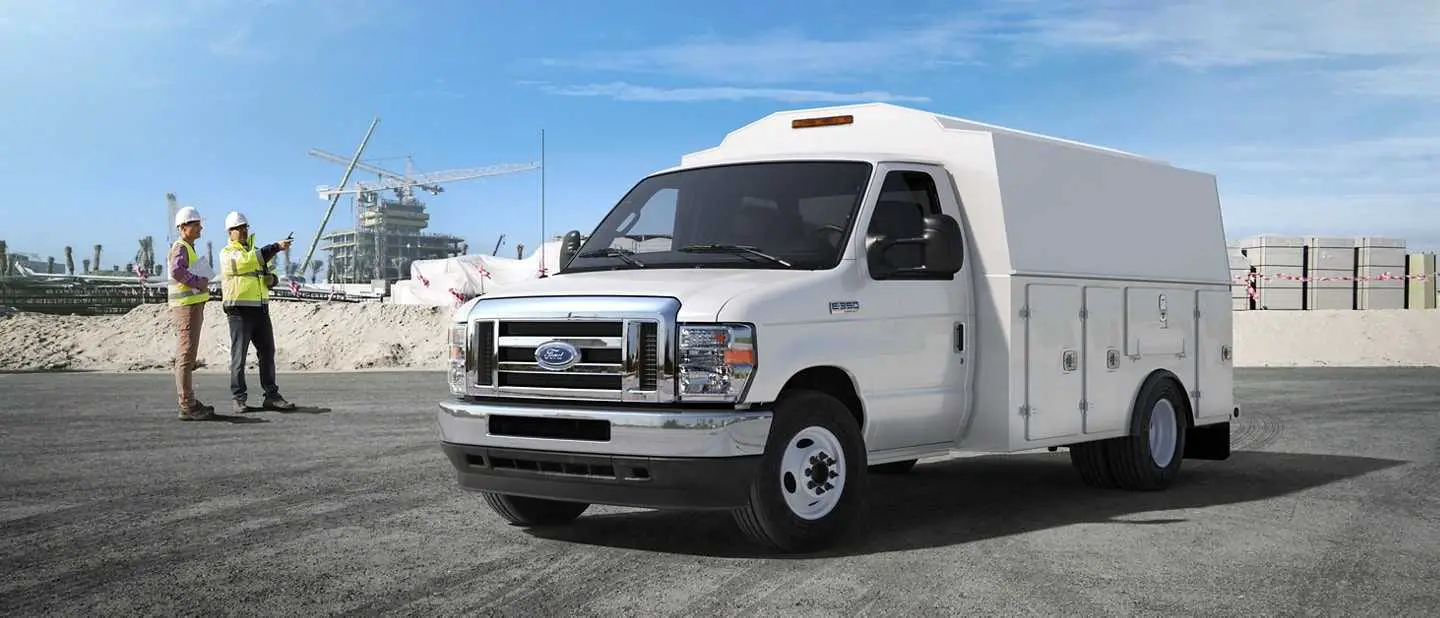FORD E-350 2023 User Guide
The 2023 Ford E-350 is a versatile and reliable workhorse that raises the bar for commercial cars in general. The E-350 is built on a foundation of strength and dependability. It has a large platform that can be changed to meet the needs of both businesses and people. This powerhouse’s iconic design and rugged body give it a sense of confidence on the road, and its strong performance makes it a reliable partner for any job. The E-350 puts the safety and comfort of both the driver and the passengers first. It has high-tech safety features and the latest technology. Inside the roomy car, clever storage solutions and ergonomic design elements make sure that every trip is easy and quick. The 2023 Ford E-350 is a real workhorse that embodies Ford’s commitment to durability, flexibility, and consistent performance. It’s the best choice for anyone who needs a reliable vehicle.
FORD E-350 2023 Introduction User Guide
2023 FORD E-350 Introduction And Replacement Parts | Specs
Introduction
Thank you for choosing Ford. We recommend that you take some time to get to know your vehicle by reading this manual. The more that you know about your vehicle, the greater the safety and pleasure you will get from driving it.
WARNING:
Driving while distracted can result in loss of vehicle control, crash and injury. We strongly recommend that you use extreme caution when using any device that may take your focus off the road. Your primary responsibility is the safe operation of your vehicle. We recommend against the use of any hand-held device while driving and encourage the use of voice-operated systems when possible. Make sure you are aware of all applicable local laws that may affect the use of electronic devices while driving.
Note:
This manual describes product features and options available throughout the range of available models, sometimes even before they are generally available. It may describe options not fitted to the vehicle you have purchased.
Note: Some of the illustrations in this manual may show features as used in different models, so may appear different to you on your vehicle.
Note: Always use and operate your vehicle in line with all applicable laws and regulations.
Note: Pass on this manual when selling your vehicle. It is an integral part of your vehicle.
This manual may qualify the location of a component as the lefthand side or right-hand side. The side is determined when facing forward in the seat.
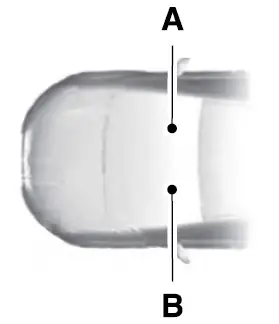
A right-hand side.
B Left-hand side.
 Air conditioning system
Air conditioning system Air conditioning system lubricant type
Air conditioning system lubricant type Anti-lock braking system
Anti-lock braking system Avoid smoking, flames or sparks
Avoid smoking, flames or sparks Battery
Battery Battery acid
Battery acid Brake fluid – nonpetroleum based
Brake fluid – nonpetroleum based Brake system
Brake system Brake system
Brake system Cabin air filter
Cabin air filter Check fuel cap
Check fuel cap Child safety door lock or unlock
Child safety door lock or unlock Child seat lower anchor
Child seat lower anchor Child seat tether anchor
Child seat tether anchor Cruise control
Cruise control Do not open when hot
Do not open when hot Engine air filter
Engine air filter Engine coolant
Engine coolant Engine coolant
Engine coolant temperature Engine oil
temperature Engine oil Explosive gas
Explosive gas Fan warning
Fan warning Fasten seatbelt
Fasten seatbelt Flammable
Flammable Front airbag
Front airbag Front fog lamps
Front fog lamps Fuel pump reset
Fuel pump reset Fuse compartment
Fuse compartment Hazard flashers
Hazard flashers Heated rear window
Heated rear window Windshield defrosting system
Windshield defrosting system Interior luggage compartment release
Interior luggage compartment release Jack
Jack Keep out of reach of children
Keep out of reach of children Lighting control
Lighting control Low tire pressure warning
Low tire pressure warning Maintain correct fluid level
Maintain correct fluid level Note operating instructions
Note operating instructions Horn control
Horn control Panic alarm
Panic alarm Parking aid
Parking aid Parking brake
Parking brake Power steering fluid
Power steering fluid
Read all Instructions for Introduction User Guide
FORD E-350 2023 Data Privacy User Guide
2023 FORD E-350 Data Privacy And Instrument Panel | Specifications
Data Privacy
WARNING: Do not connect wireless plug-in devices to the data link connector. Unauthorized third parties could gain access to vehicle data and impair the performance of safety-related systems. Only allow repair facilities that follow our service and repair instructions to connect their equipment to the data link connector.
We respect your privacy and are committed to protecting it. The information contained in this publication was correct at the time of release, but as technology rapidly changes, we recommend that you visit the local Ford website for the latest information.
Your vehicle has electronic control units that have data recording functionality and the ability to permanently or temporarily store data. This data could include information on the condition and status of your vehicle, vehicle maintenance requirements, events and malfunctions. The types of data that can be recorded are described in this section. Some of the data recorded is stored in event logs or error logs.
Note: Error logs are reset following a service or repair.
Note: We may provide information in response to requests from law enforcement, other government authorities and third parties acting with lawful authority or through a legal process. Such information could be used by them in legal proceedings.
Data recorded includes, for example:
- Operating states of system components, for example, fuel level, tire pressure and battery charge level.
- Vehicle and component status, for example, wheel speed, deceleration, lateral acceleration, and seatbelt status.
- Events or errors in essential systems, for example, headlamps and brakes.
- System responses to driving situations, for example, airbag deployment and stability control.
- Environmental conditions, for example, temperature.
Some of this data, when used in combination with other information, for example, an accident report, damage to a vehicle or eyewitness statements, could be associated with a specific person.
Services That We Provide
If you use our services, we collect and use data, for example, account information, vehicle location and driving characteristics, that could identify you. We transmit this data through a dedicated, protected connection. We only collect and use data to enable your use of our services to which you have subscribed, with your consent or where permitted by law. For additional information, see the terms and conditions of the services to which you have subscribed.
For additional information about our privacy policy, refer to the local Ford website.
Services That Third Parties Provide
We recommend that you review the terms and conditions and data privacy information for any services equipped with your vehicle or to which you subscribe. We take no responsibility for services that third parties provide.
SERVICE DATA
Service data recorders in your vehicle are capable of collecting and storing diagnostic information about your vehicle. This potentially includes information about the performance or status of various systems and modules in the vehicle, such as engine, throttle, steering or brake systems. In order to properly diagnose and service your vehicle, Ford Motor Company (Ford of Canada in Canada), and service and repair facilities may access or share among them vehicle diagnostic information received through a direct connection to your vehicle when diagnosing or servicing your vehicle. Additionally, Ford Motor Company (Ford of Canada, in Canada) may, where permitted by law, use vehicle diagnostic information for vehicle improvement or with other information we may have about you, for example, your contact information, to offer you products or services that may interest you.
Data may be provided to our service providers such as part suppliers that may help diagnose malfunctions, and who are similarly obligated to protect data. We retain this data only as long as necessary to perform these functions or to comply with law. We may provide information where required in response to official requests to law enforcement or other government authorities or third parties acting with lawful authority or court order, and such information may be used in legal proceedings. For U.S. only (if equipped), if you choose to use connected apps and services, you consent that certain diagnostic information may also be accessed electronically by Ford Motor Company and Ford authorized service facilities and that the diagnostic information may be used to provide services to you, personalizing your experience, troubleshoot, and to improve products and services and offer you products and services that may interest you, where permitted by law.
For Canada only, for more information, please review the Ford of Canada privacy policy at www.ford.ca, including our U.S. data storage and use of service providers in other jurisdictions who may be subject to legal requirements in Canada, the United States and other countries applicable to them, for example, lawful requirements to disclose personal information to governmental authorities in those countries.
EVENT DATA
This vehicle is equipped with an event data recorder. The main purpose of an event data recorder is to record, in certain crashes or near crash-like situations, such as an airbag deployment or hitting a road obstacle; this data will assist in understanding how a vehicle’s systems performed. The event data recorder is designed to record data related to vehicle dynamics and safety systems for a short period of time, typically 30 seconds or less.
The event data recorder in this vehicle is designed to record such data as:
- How various systems in your vehicle were operating?
- Whether or not the driver and passenger seatbelts were buckled/fastened.
- How far (if at all) the driver was depressing the accelerator and/or the brake pedal?
- How fast the vehicle was traveling.
- Where the driver was positioning the steering wheel.
This data can help provide a better understanding of the circumstances in which crashes and injuries occur.
Note: Event data recorder data is recorded by your vehicle only if a non-trivial crash situation occurs; no data is recorded by the event data recorder under normal driving conditions and no personal data or information (for example name, gender, age, and crash location) is recorded. However, parties, such as law enforcement, could combine the event data recorder data with the type of personally identifying data routinely acquired during a crash investigation.
To read data recorded by an event data recorder, special equipment is required, and access to the vehicle or the event data recorder is needed. In addition to the vehicle manufacturer, other parties, such as law enforcement, that have such special equipment, can read the information if they have access to the vehicle or the event data recorder.
SETTINGS DATA
Your vehicle has electronic control units that have the ability to store data based on your personalized settings. The data is stored locally in the vehicle or on devices that you connect to it, for example, a USB drive or digital music player. You can delete some of this data and also choose whether to share it through the services to which you subscribe.
Comfort and Convenience Data
Data recorded includes, for example:
- Seat and steering wheel position.
- Climate control settings.
- Radio presets.
Entertainment Data
Data recorded includes, for example:
- Music, videos or album art.
- Contacts and corresponding address book entries.
- Navigation destinations.
Read all Instructions for Data Privacy User Guide
FORD E-350 2023 Child Safety User Guide
2023 FORD E-350 Child Safety Instruction
GENERAL INFORMATION
See the following sections for directions on how to properly use safety restraints for children.
WARNING: Always make sure your child is secured properly in a device that is appropriate for their height, age, and weight. Child safety restraints must be bought separately from your vehicle. Failure to follow these instructions and guidelines may result in an increased risk of serious injury or death to your child.
WARNING: All children are shaped differently. The National Highway Traffic Safety Administration and other safety organizations, base their recommendations for child restraints on probable child height, age and weight thresholds, or on the minimum requirements of the law. We recommend that you check with an NHTSA Certified Child Passenger Safety Technician (CPST) to make sure that you properly install the child restraint in your vehicle and that you consult your pediatrician to make sure you have a child restraint appropriate for your child. To locate a child restraint fitting station and CPST, contact NHTSA toll-free at
1-888-327-4236 or go to www.nhtsa.dot.gov. In Canada, contact Transport Canada toll-free at
1-800-333-0371 or go to www.tc.gc.ca to find a Child Car Seat Clinic in your area. Failure to properly restrain children in child restraints made especially for their height, age and weight, may result in an increased risk of serious injury or death to your child.
WARNING: On hot days, the temperature inside the vehicle can rise very quickly. Exposure of people or animals to these high temperatures for even a short time can cause death or serious heat-related injuries, including brain damage. Small children are particularly at risk.
Recommendations for Safety Restraints for Children
| Child | Child Size, Height, Weight, or Age | Recommended Restraint Type |
|
Infants or toddlers |
Children weighing 40 lb (18 kg) or less (generally age four or younger). |
Use a child restraint (sometimes called an infant carrier, convertible seat, or toddler seat). |
|
Small children |
Children who have outgrown or no longer properly fit in a child restraint (generally children who are less than 57 in (1.45 m) tall, are greater than age four and less than age 12, and between 40 lb (18 kg) and 80 lb (36 kg) and upward to 100 lb (45 kg) if recommended by your child restraint manufacturer). |
Use a belt-positioning booster seat. |
|
Larger children |
Children who have outgrown or no longer properly fit in a belt-positioning booster seat (generally children who are at least 57 in (1.45 m) tall or greater than 80 lb (36 kg) or 100 lb (45 kg) if recommended by child restraint manufacturer). | Use a vehicle seatbelt having the lap belt snug and low across the hips, shoulder belt centered across the shoulder and chest, and seat backrest upright. |
- You are required by law to properly use child restraints for infants and toddlers in the United States and Canada.
- Many states and provinces require that small children use approved booster seats until they reach age eight, a height of 57 in (1.45 m) tall, or 80 lb (36 kg). Check your local and state or provincial laws for specific requirements about the safety of children in your vehicle.
- When possible, always properly restrain children 12 years of age and under in the rear seating position of your vehicle. Accident statistics suggest that children are safer when properly restrained in the rear seating position than in a front seating position.
- When installing a rear-facing child restraint, adjust the vehicle seats to avoid interference between the child restraint and the vehicle seat in front of the child restraint.
INSTALLING CHILD RESTRAINTS
Child Seats 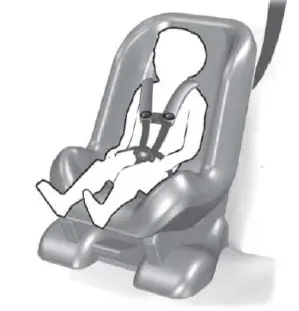
Use a child restraint (sometimes called an infant carrier, convertible seat, or toddler seat) for infants, toddlers, or children weighing 40 lb (18 kg) or less (generally age four or younger).
Using Lap and Shoulder Belt
WARNING: Do not place a rearward-facing child restraint in front of an active airbag. Failure to follow this instruction could result in personal injury or death.
WARNING: Properly secure children 12 years old and under in a rear seating position whenever possible. If you are unable to properly secure all children in a rear seating position, properly secure the largest child on the front seat. If you must use a forward-facing child restraint on the front seat, move the seat as far back as possible. Failure to follow these instructions could result in personal injury or death.
WARNING: Depending on where you secure a child restraint, and depending on the child restraint design, you may block access to certain seatbelt buckle assemblies and LATCH lower anchors, rendering those features potentially unusable. To avoid risk of injury, make sure occupants only use seating positions where they are able to be properly restrained.
When installing a child restraint with combination lap and shoulder belts:
- Use the correct seatbelt buckle for that seating position.
- Insert the belt tongue into the proper buckle until you hear a snap and feel it latch. Make sure the tongue is securely fastened in the buckle.
- Keep the buckle release button pointing up and away from the child restraint, with the tongue between the child restraint and the release button, to prevent accidental unbuckling. Place the vehicle seat in the upright position before you install the child restraint.
- Put the seatbelt in the automatic locking mode. See Step 5. This vehicle does not require the use of a locking clip.
Perform the following steps when installing the child restraint with combination lap and shoulder belts:
Note: Although the child restraint illustrated is a forward-facing child restraint, the steps are the same for installing a rear-facing child restraint.
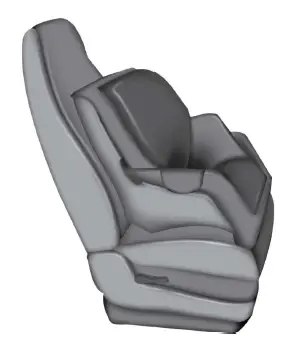
- Position the child restraint in a seat with a combination lap and shoulder belt.
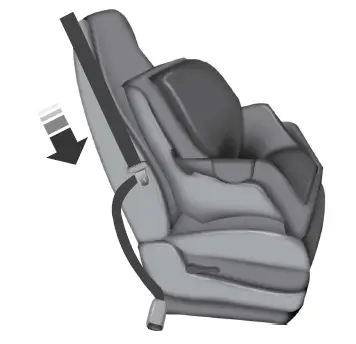
Read all Instructions for Child Safety User Guide
FORD E-350 2023 Seatbelts User Guide
2023 FORD E-350 Seatbelts | How To Use
Seatbelts
PRINCIPLE OF OPERATION
WARNING: Always drive and ride with the seat backrest upright and the lap belt snug and low across the hips.
WARNING: To reduce the risk of injury, make sure children sit where they can be properly restrained.
WARNING: Never let a passenger hold a child on his or her lap while your vehicle is moving. The passenger cannot protect the child from injury in a crash which may result in serious injury or death.
WARNING: All occupants of the vehicle, including the driver, should always properly wear their safety belts, even when an airbag supplemental restraint system is provided. Failure to properly wear your safety belt could seriously increase the risk of injury or death.
WARNING: It is extremely dangerous to ride in a cargo area, inside or outside of a vehicle. In a crash, people riding in these areas are more likely to be seriously injured or killed. Do not allow people to ride in any area of your vehicle that is not equipped with seats and safety belts. Be sure everyone in your vehicle is in a seat and using a safety belt properly.
WARNING: In a rollover crash, an unbelted person is significantly more likely to die than a person wearing a safety belt.
WARNING: Each seating position in your vehicle has a specific safety belt assembly which is made up of one buckle and one tongue that are designed to be used as a pair. 1) Use the shoulder belt on the outside shoulder only. Never wear the shoulder belt under the arm. 2) Never swing the safety belt around your neck over the inside shoulder. 3) Never use a single belt for more than one person.
WARNING: When possible, all children 12 years old and under should be properly restrained in a rear seating position. Failure to follow this could seriously increase the risk of injury or death.
WARNING: Safety belts and seats can become hot in a vehicle that has been closed up in sunny weather; they could burn a small child. Check seat covers and buckles before you place a child anywhere near them.
WARNING: Front and rear seat occupants, including pregnant women, should wear safety belts for optimum protection in an accident.
All seating positions in this vehicle have lap and shoulder safety belts. All occupants of the vehicle should always properly wear their safety belts, even when an airbag supplemental restraint system is provided.
The safety belt system consists of:
- Lap and shoulder safety belts.
- Shoulder safety belt with automatic locking mode, (except driver safety belt).
- Height adjuster at the front outboard seating positions.
- Safety belt pretensioner at the front outboard seating positions.
 Safety belt warning light and chime.
Safety belt warning light and chime. Crash sensors and monitoring system with readiness indicator.
Crash sensors and monitoring system with readiness indicator.
The safety belt pretensioners at the front seating positions are designed to tighten the safety belts when activated. In frontal and near-frontal crashes, the safety belt pretensioners may be activated alone or, if the crash is of sufficient severity, together with the front airbags.
FASTENING THE SEATBELTS
The front outboard safety restraints in the vehicle are combination lap and shoulder belts.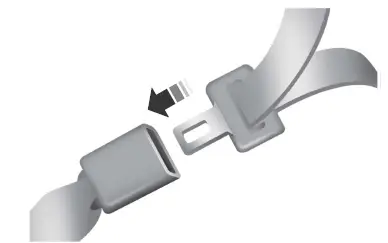
- Insert the belt tongue into the proper buckle (the buckle closest to the direction the tongue is coming from) until you hear a snap and feel it latch. Make sure the tongue is securely fastened in the buckle.

- To unfasten, press the release button and remove the tongue from the buckle.
Using Seatbelts During Pregnancy
WARNING: Always ride and drive with your seatback upright and properly fasten your seatbelt. Fit the lap portion of the seatbelt snugly and low across the hips. Position the shoulder portion of the seatbelt across your chest. Pregnant women must follow this practice. See the following figure.
WARNING: Always ride and drive with your seatback upright and properly fasten your seatbelt. Fit the lap portion of the seatbelt snugly and low across the hips. Position the shoulder portion of the seatbelt across your chest. Pregnant women must follow this practice. See the following figure.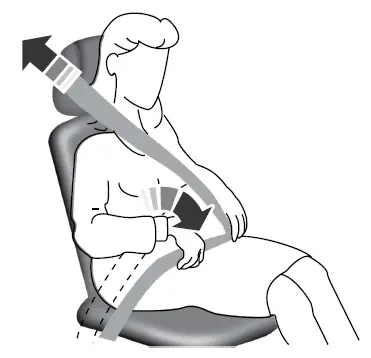
Pregnant women should always wear seatbelts. Position the lap belt portion of a combination lap and shoulder belt low across the hips below the belly and worn as tight as comfort allows. Position the shoulder belt to cross the middle of the shoulder and the center of the chest.
Seatbelt Locking Modes
WARNING: If your vehicle is involved in a crash, have the seatbelts and associated components inspected as soon as possible. Failure to follow this instruction could result in personal injury or death.
All safety restraints in the vehicle are combination lap and shoulder belts. The driver seatbelt has the first type of locking mode. The front outboard passenger seatbelt has both types of locking modes described as follows:
Vehicle Sensitive Mode
This is the normal retractor mode, which allows free shoulder belt length adjustment to your movements and locking in response to vehicle movement. For example, if the driver brakes suddenly or turns a corner sharply, or the vehicle receives an impact of about 5 mph (8 km/h) or more, the combination seatbelts lock to help reduce the forward movement of the driver and passengers.
In addition, the retractor is designed to lock if you pull the webbing out too quickly. If the seatbelt retractor locks, slowly lower the height adjuster to allow the seatbelt to retract. If the retractor does not unlock, pull the seatbelt out slowly then feed a small length of webbing back toward the stowed position. For rear seatbelts, recline the rear seat backrest or push the seat backrest cushion away from the seatbelt. Feed a small length of webbing back toward the stowed position.
Automatic Locking Mode
In this mode, the shoulder belt automatically pre-locks. The belt will still retract to remove any slack in the shoulder belt. The automatic locking mode is not available on the driver seatbelt.
When to Use the Automatic Locking Mode
Use this mode any time a child safety seat, except a booster, is installed in the passenger front seating position. See Child Safety (page 20).
How to Use the Automatic Locking Mode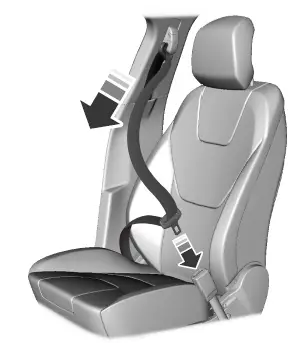
- Buckle the combination lap and shoulder belt.
- Grasp the shoulder portion and pull downward until the entire belt is pulled out.
- Allow the belt to retract. As the belt retracts, you will hear a clicking sound. This indicates the seatbelt is now in automatic locking mode.
How to Disengage the Automatic Locking Mode
Unbuckle the combination lap and shoulder belt and allow it to retract completely to disengage the automatic locking mode and activate the vehicle-sensitive (emergency) locking mode.
Read all Instructions for Seatbelts User Guide
FORD E-350 2023 Supplementary Restraints System User Guide
2023 FORD E-350 Supplementary Restraints System
Supplementary Restraints System
PRINCIPLE OF OPERATION
WARNING: Airbags do not inflate slowly or gently, and the risk of injury from a deploying airbag is the greatest close to the trim covering the airbag module.
WARNING: All occupants of your vehicle, including the driver, should always properly wear their seatbelts, even when an airbag supplemental restraint system is provided. Failure to properly wear your seatbelt could seriously increase the risk of injury or death.
WARNING: Properly secure children 12 years old and under in a rear seating position whenever possible. If you are unable to properly secure all children in a rear seating position, properly secure the largest child on the front seat. If you must use a forward-facing child restraint on the front seat, move the seat as far back as possible. Failure to follow these instructions could result in personal injury or death.
WARNING: Do not place your arms on the airbag cover or through the steering wheel. Failure to follow this instruction could result in personal injury.
WARNING: Do not place a rearward-facing child restraint in front of an active airbag. Failure to follow this instruction could result in personal injury or death.
WARNING: Do not attempt to service, repair, or modify the supplementary restraint system or associated components. Failure to follow this instruction could result in personal injury or death.
WARNING: Several airbag system components get hot after inflation. To reduce the risk of injury, do not touch them after inflation.
WARNING: If a supplementary restraint system component has been deployed, it will not function again. Have the system and associated components inspected as soon as possible? Failure to follow this instruction could result in personal injury or death.
The airbags are a supplemental restraint system and are designed to work with the seatbelts to help protect the driver and right-front passenger from certain upper body injuries. Airbags do not inflate slowly; there is a risk of injury from a deploying airbag.
Note: You will hear a loud bang and see a cloud of harmless powdery residue if an airbag deploys. This is normal.
The airbags inflate and deflate rapidly upon activation. After airbag deployment, it is normal to notice a smoke-like, powdery residue or smell the burnt propellant. This may consist of cornstarch, talcum powder (to lubricate the bag) or sodium compounds (for example, baking soda) that result from the combustion process that inflates the airbag. Small amounts of sodium hydroxide may be present which may irritate the skin and eyes, but none of the residues is toxic.
While the system is designed to help reduce serious injuries, contact with a deploying airbag may also cause abrasions or swelling. Temporary hearing loss is also a possibility as a result of the noise associated with a deploying airbag. Because airbags must inflate rapidly and with considerable force, there is the risk of death or serious injuries such as fractures, facial and eye injuries or internal injuries, particularly to occupants who are not properly restrained or are otherwise out of position at the time of airbag deployment. Thus, it is extremely important that occupants be properly restrained as far away from the airbag module as possible while maintaining vehicle control.
Routine maintenance of the airbags is not required.
DRIVER AND PASSENGER AIRBAGS
WARNING: Do not place your arms on the airbag cover or through the steering wheel. Failure to follow this instruction could result in personal injury.
WARNING: Do not place a rearward-facing child restraint in front of an active airbag. Failure to follow this instruction could result in personal injury or death.
The driver and front passenger airbags deploy during significant frontal and near frontal crashes.
The driver and passenger front airbag system consist of:
- Driver and passenger airbag modules.
 Crash sensors and monitoring system with readiness indicator. See Crash Sensors and Airbag
Crash sensors and monitoring system with readiness indicator. See Crash Sensors and Airbag
Indicator (page 40).
Passenger Airbag On and Off Switch (If Equipped)
WARNING: Your vehicle may have an airbag deactivation switch. Before driving, always look at the switch to make sure it is in the appropriate position. Failure to put the switch in the proper position can increase the risk of serious injury or death in a crash.
Note: The passenger airbag on and off switch may be on vehicles with no rear seats.
Switching the Passenger Airbag Off
WARNING: If the light does not illuminate when the passenger airbag switch is off and you switch the ignition on, have the passenger airbag switch serviced immediately by a qualified technician.
WARNING: To avoid switching on the airbag, always remove the ignition key with the switch in the off position.
WARNING: NEVER use a rearward-facing child restraint on a seat protected by an ACTIVE AIRBAG in front of it, DEATH or SERIOUS INJURY to the CHILD can occur. 
- Insert the ignition key into the passenger airbag on and off switch, turn the switch to off, and hold it in off while removing the key.
- When you switch the ignition on and the passenger airbag switch is in the off position, the off light illuminates briefly, momentarily shuts off and then turns back on. This indicates that the passenger airbag is deactivated.
Switching the Passenger Airbag Back On
WARNING: The seatbelts for the driver and right-front passenger seating positions are specifically designed to operate together with the airbags in certain types of crashes. When you switch off your airbag, you not only lose the protection of the airbag, you also may reduce the effectiveness of your seatbelt system. If the passenger does not meet the requirements stated in the National Highway Traffic Safety Administration or Transport Canada deactivation criteria, switching off the airbag can increase the risk of serious injury or death in a crash.
WARNING: If your vehicle has rear seats, always transport children who are 12 and younger in the rear seat. Always use seatbelts and child restraints properly. Do not place a child in a rear-facing infant seat in the front seat unless your vehicle is equipped with an airbag on and off switch and the passenger airbag is turned off. This is because the back of the infant seat is too close to the inflating airbag and the risk of a fatal injury to the infant when the airbag inflates is substantial.
WARNING: If the passenger airbag off light is illuminated when the passenger airbag switch is on and the ignition is on, have the passenger airbag switch serviced immediately by a qualified technician.
The passenger airbag remains off until you switch it back on.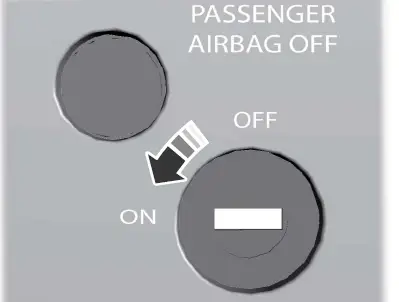
- Insert the ignition key into the passenger airbag on and off switch and turn the switch to on.
- The off light briefly illuminates when you switch the ignition on. This indicates that the passenger airbag is operational.
The passenger side airbag should always be on (the airbag off light should not be illuminated) unless the passenger is a person who meets the requirements stated either in Category 1, 2 or 3 of the National Highway Traffic Safety Administration/Transport Canada deactivation criteria which follow.
The vast majority of drivers and passengers are much safer with an airbag than without. To do their job and reduce the risk of life-threatening injuries, airbags must open with great force, and this force can pose a potentially deadly risk in some situations, particularly when a front seat occupant is not properly buckled up. The most effective way to reduce the risk of unnecessary airbag injuries without reducing the overall safety of the vehicle is to make sure all occupants are properly restrained in the vehicle, especially in the front seat. This provides the protection of seatbelts and permits the airbags to provide the additional protection they were designed to provide. If you choose to deactivate your airbag, you are losing very significant risk-reducing benefits of the airbag and you are also reducing the effectiveness of the seatbelts because seatbelts in modern vehicles are designed to work as a safety system with the airbags.
National Highway Traffic Safety Administration Deactivation Criteria (Excluding Canada)
WARNING: This vehicle has special energy management seatbelts for the driver and right-front passenger. These particular seatbelts are specifically designed to work with airbags to help reduce the risk of injury in a crash. The energy management seatbelt gives or releases additional seatbelt webbing in some accidents to reduce the concentration of force on an occupant’s chest and to reduce the risk of certain bone fractures and injuries to underlying organs. In a crash, if the airbag is off, this energy management seatbelt might permit the passenger wearing the seatbelt to move forward enough to have a serious or fatal injury. The more severe the crash, and the heavier the occupant, the greater the risk. Make sure the airbag is on for any passenger who does not qualify under the National Highway Traffic Safety Administration deactivation criteria.
- Infant. An infant (less than 1 year old) must ride in the front seat because:
- The vehicle has no rear seat.
- The vehicle has a rear seat too small to accommodate a rear-facing infant seat.
- The infant has a medical condition which, according to the infant’s physician, makes it necessary for the infant to ride in the front so that the driver can constantly monitor the child’s condition.
- Child age 1 to 12. A child age 1 to 12 must ride in the front seat because:
- The vehicle has no rear seat.
- Although children ages 1 to 12 ride in the rear seat(s) whenever possible, children ages 1 to 12 sometimes must ride in the front because no space is available in the rear seat(s) of the vehicle.
- The child has a medical condition which, according to the child’s physician, makes it necessary for the child to ride in the front seat so that the driver can constantly monitor the child’s condition.
- Medical condition. A passenger has a medical condition which, according to his or her physician:
- This causes the passenger airbag to pose a special risk for the passenger.
- Makes the potential harm from the passenger airbag in a crash greater than the potential harm from turning off the airbag and allowing the passenger, even if belted, to hit the dashboard or windshield in a crash.
Read all Instructions for Supplementary Restraints System User Guide
FORD E-350 2023 Keys and Remote Controls User Guide
2023 FORD E-350 Keys and Remote Controls | Use Security system
Keys and Remote Controls
GENERAL INFORMATION ON RADIO FREQUENCIES
This device complies with Part 15 of the FCC Rules and with Licence-exempt RSS Standards of Industry Canada. Operation is subject to the following two conditions:
- This device may not cause harmful interference.
- This device must accept any interference received, including interference that may cause undesired operation.
WARNING: Changes or modifications not expressively approved by the party responsible for compliance could void the user’s authority to operate the equipment. The term “IC:” before the radio certification number only signifies that Industry Canada’s technical specifications were met.
The typical operating range for your transmitter is approximately 33 ft (10 m). Vehicles with the remote start feature will have a greater range. One of the following could cause a decrease in the operating range:
- Weather conditions.
- Nearby radio towers.
- Structures around the vehicle.
- Other vehicles parked next to your vehicle.
Other short-distance radio transmissions, for example, amateur radios, medical equipment, wireless headphones, remote controls and alarm systems can also use the radio frequency used by your remote control. If the frequencies are jammed, you will not be able to use your remote control. You can lock and unlock the doors with the key.
Note: Make sure to lock your vehicle before leaving it unattended.
Note: If you are in range, the remote control will operate if you press any button unintentionally.
Note: The remote control contains sensitive electrical components. Exposure to moisture or impact may cause permanent damage.
REMOTE CONTROL
(IF EQUIPPED)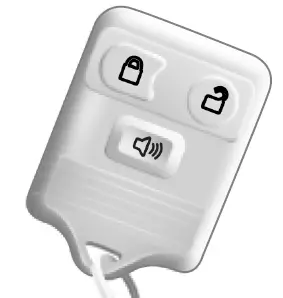
Note: If there are problems with the remote entry system, make sure to take all remote entry transmitters with you to an authorized dealer in order to aid in troubleshooting the problem.
Note: If your vehicle is fitted with the
E-Guard Cargo Protection System™, the remote transmitter unlock command only unlocks the front doors. The side or rear cargo doors can only be unlocked from outside your vehicle using the key.
Changing the Remote Control Battery
WARNING: Keep batteries away from children to prevent ingestion. Failure to follow this instruction could result in personal injury or death. If ingested, immediately seek medical attention.
WARNING: If the battery compartment does not securely close, stop using the remote control and replace it as soon as possible. In the meantime, keep the remote control away from children. Failure to follow this instruction could result in personal injury or death.
The remote control uses one coin-type three-volt lithium battery CR2032 or equivalent.![]() Make sure that you dispose of old batteries in an environmentally friendly way. Seek advice from your local authority about recycling old batteries.
Make sure that you dispose of old batteries in an environmentally friendly way. Seek advice from your local authority about recycling old batteries.
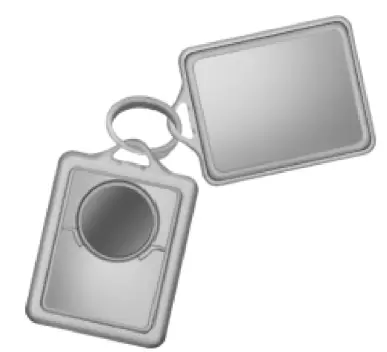
- Twist a thin coin in the slot of the transmitter near the key ring to remove the battery cover.
Note: Do not remove the rubber cover and circuit board from the front housing of the remote entry transmitter.
Note: Do not wipe off any grease on the battery terminals or on the back surface of the circuit board. - Remove the old battery.
- Insert the new battery. Refer to the symbols inside the transmitter for the correct orientation of the battery. Press the battery down to make sure it is fully engaged in the housing.
- Reinstall the battery housing cover onto the transmitter.
Note: Replacing the battery does not erase the programmed key from your vehicle. The transmitter should operate normally.
Read all Instructions for Keys and Remote Controls User Guide
FORD E-350 2023 Steering Wheel User Guide
2023 FORD E-350 Steering Wheel, Wipers And Washers Instructions
ADJUSTING THE STEERING WHEEL
WARNING: Do not adjust the steering wheel when your vehicle is moving.
Note: Make sure that you are sitting in the correct position. See Sitting in the Correct Position (page 77). 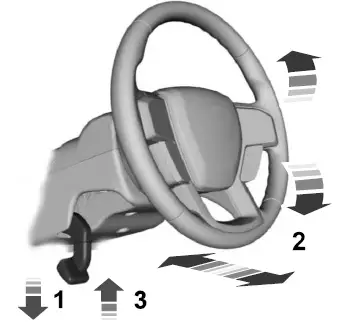
- Unlock the steering column.
- Adjust the steering wheel to the position you prefer.
- Lock the steering column.
CRUISE CONTROL – VEHICLES WITH: ADAPTIVE CRUISE CONTROL
See Using Adaptive Cruise Control (page 108).
CRUISE CONTROL – VEHICLES WITH: CRUISE CONTROL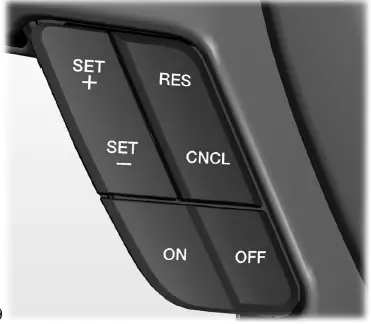
See What Is Cruise Control (page 107).
INFORMATION DISPLAY CONTROL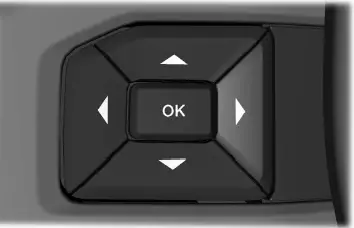
See Information Displays (page 65).
HORN
Wipers and Washers
WINDSHIELD WIPERS
Note: Fully defrost the windshield before you switch the windshield wipers on.
Note: Make sure you switch the windshield wipers off before entering a car wash.
Note: If streaks or smears appear on the windshield, clean the windshield and the wiper blades. If that does not resolve the issue, install new wiper blades.
Note: Do not operate the wipers on a dry windshield. This may scratch the glass, damage the wiper blades or cause the wiper motor to burn out. Always use the windshield washers before wiping a dry windshield.
- Rotate away from you for a long wipe interval.
- Rotate toward you for a short wipe interval.
Speed Dependent Wipers
When your vehicle speed increases, the interval between wipes decreases.
WINDSHIELD WASHERS

- A brief press causes a single wipe without washer fluid.
- A brief press and hold cause the wipers to swipe three times with washer fluid.
- A long press and hold turns on the wipers and washer fluid for up to 10 seconds.
A wipe occurs a few seconds after washing to clear any remaining washer fluid. You can switch this feature on or off in the information display. See Information Displays (page 65).
Note: Do not operate the washers when the washer reservoir is empty. This could cause the washer pump to overheat.
Lighting
GENERAL INFORMATION
Condensation in the Exterior Front Lamps and Rear Lamps
Exterior front lamps and rear lamps have vents to accommodate normal changes in air pressure.
Condensation can be a natural by-product of this design. When moist air enters the lamp assembly through the vents, there is a possibility that condensation can occur when the temperature is cold. When normal condensation occurs, a fine mist can form on the interior of the lens. The fine mist eventually clears and exits through the vents during normal operation. Clearing time may take as long as 48 hours under dry weather conditions.
Examples of acceptable condensation are:
- The presence of a fine mist (no streaks, drip marks or large droplets).
- A fine mist covers less than 50% of the lens.
Examples of unacceptable condensation are: - A water puddle inside the lamp.
- Streaks, drip marks or large droplets are present on the interior of the len
- s.
If you see any unacceptable condensation, have your vehicle checked by an authorized dealer.
Read all Instructions for Steering Wheel User Guide
FORD E-350 2023 Automatic High Beam Control User Guide
2023 FORD E-350 Automatic High Beam Control System And Instrument Cluster
WHAT IS AUTOMATIC HIGH BEAM CONTROL
The system turns on high beams if it is dark enough and no other traffic is present. If it detects an approaching vehicle’s headlamps or tail lamps, or street lighting ahead, the system turns the high beams off. Low beams remain on.
A camera sensor, centrally mounted behind the windshield of your vehicle, continuously monitors conditions to turn the high beams on and off.
SWITCHING AUTOMATIC HIGH BEAM CONTROL ON AND OFF
Switch the system on or off using the information display. See General Information (page 65).
Activating the Automatic High Beam Control![]() Switch the lighting control to the auto lamp’s position to activate. See Autolamps (page 53).
Switch the lighting control to the auto lamp’s position to activate. See Autolamps (page 53).
Note: Automatic high beams are not available when you do not turn on auto lamps.
When active, the high beams turn on if all of the following occur:
- The ambient light level is low enough.
- There is no traffic in front of your vehicle.
- The vehicle speed is greater than approximately 32 mph (52 km/h).
When active, the high beams turn off if any of the following occur:
- The ambient light level is high enough that it does not require high beams.
- The system detects an approaching vehicle’s headlamps or tail lamps.
- The system detects severe rain, snow or fog.
- The camera is blocked.
- The vehicle speed falls below approximately 27 mph (44 km/h).
Note: The deactivation speed is lower on curves.
Note: There could be a delay in high beam reactivation in certain curvy road situations.
Note: If you have a blocked sensor, the system may not operate properly. Keep the windshield free from obstruction or damage.
Note: The system may not operate properly in cold or inclement conditions. You can switch on the high beams by overriding the system.
Note: If the system detects a blockage, for example, bird droppings, bug splatter, snow or ice, the system goes into low beam mode until you clear the blockage. If you have a blocked camera, a message may appear in the information display.
Note: Using much larger tires or equipping vehicle accessories such as snowplows can modify your vehicle’s ride height and degrade automatic high beam control performance.
AUTOMATIC HIGH BEAM CONTROL INDICATORS
![]() The indicator illuminates to confirm when the system is ready to assist.
The indicator illuminates to confirm when the system is ready to assist.
OVERRIDING AUTOMATIC HIGH BEAM CONTROL
WARNING: The system does not relieve you of your responsibility to drive with due care and attention. You may need to override the system if it does not turn the high beams on or off.
WARNING: You may need to override the system when approaching other road users.
WARNING: You may need to override the system during inclement weather. 
Push the lever away from you to switch between the high beam and the low beam.
Windows and Mirrors
POWER WINDOWS
(IF EQUIPPED)
WARNING: Do not leave children unattended in your vehicle and do not let them play with the power windows. Failure to follow this instruction could result in personal injury.
WARNING: When closing the power windows, verify they are free of obstruction and make sure that children and pets are not in proximity of the window openings. 
Note: You may hear a pulsing noise when just one of the windows is open. Lower the opposite window slightly to reduce this noise.
Press the switch to open the window. Lift the switch to close the window.
One-Touch Down
Press the switch fully and release it. Press again or lift it to stop the window.
Accessory Delay
You can use the window switches for several minutes when you switch the ignition off or until you open either front door.
EXTERIOR MIRRORS
(IF EQUIPPED)
Power Exterior Mirrors (If Equipped)
WARNING: Do not adjust the mirrors when your vehicle is moving.
- A Left mirror.
- B Off.
- C Right mirror.
To adjust your mirrors:
- Select the mirror you want to adjust.
- Move the control in the direction you want to tilt the mirror.
- Return the control to the center position to lock the mirrors in place.
Fold-Away Exterior Mirrors
Push the mirror toward the door window glass. Make sure that you fully engage the mirror in its support when returning it to its original position.
Telescoping Mirrors (If Equipped)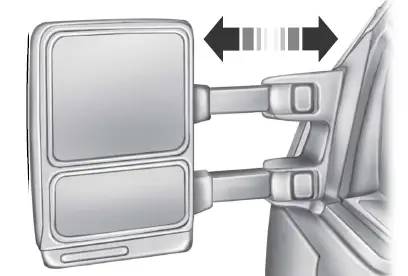
Read all Instructions for Automatic High Beam Control User Guide
FORD E-350 2023 Information Displays User Guide
FORD E-350 2023 How to Use Information Displays
Information Displays
WARNING: Driving while distracted can result in loss of vehicle control, crash, and injury. We strongly recommend that you use extreme caution when using any device that may take your focus off the road. Your primary responsibility is the safe operation of your vehicle. We recommend against the use of any hand-held device while driving and encourage the use of voice-operated systems when possible. Make sure you are aware of all applicable local laws that may affect the use of electronic devices while driving.
Note: Trailer options are not available if your vehicle speed is greater than 3 mph (5 km/h).
Information Display Controls
- Press the up and down arrow buttons to scroll through and highlight the options within a menu.
- Press the right arrow button to enter a sub-menu.
- Press the left arrow button to exit a menu.
- Press the OK button to choose and confirm settings or messages.
![]() This icon shows the features on or off status. A check in the box indicates the feature is on, and unchecked indicates the feature is off.
This icon shows the features on or off status. A check in the box indicates the feature is on, and unchecked indicates the feature is off.
2.3 Inch Display Menu
Note: Some options could appear slightly different or not at all if the items are optional.
| Main Menu |
| Trip 1 |
| Trip 2 |
| Fuel Economy |
| Driver Assist |
| Settings |
Trip 1 or 2
Displays the following of an individual journey.
- Digital speed.
- Distance.
- Time.
- Distance to empty.
- Average fuel economy.
Note: Hold OK to reset fuel history and average fuel economy.
Fuel Economy
Displays the following:
Settings
- Instant fuel economy.
- Average fuel economy.
- Average speed.
- Distance to empty.
Note: Hold OK to reset fuel history and average fuel economy.
Driver Assist
Displays the following:
- Progressive range select.
- Engine hours.
- Maintenance monitor.
| Settings | ||
| Vehicle | Lighting | Select Your Setting |
| Locks | ||
| FordPass | ||
| Windows | ||
| Wiper Controls | ||
| Displ. Settings | Units | Select Your Setting |
| Temperature | ||
| Language | ||
8 Inch Display Menu
Note: Some options could appear slightly different or not at all if the items are optional.
| Main Menu |
| MyView |
| Trip/Fuel |
| Vehicle Info |
| Settings |
MyView
| MyView | |
| Trip 1 | |
| Fuel Economy | |
| Configure MyView | For more options, press the OK button. |
Trip/Fuel
| Trip/Fuel |
| Trip 1 |
| Trip 2 |
| Fuel Economy |
| Fuel History |
Trip 1 or 2
Displays the following of an individual journey.
- Trip timer.
- Distance to empty.
- Trip odometer.
- Average fuel economy.
Note: Hold OK to reset fuel history and average fuel economy.
Fuel Economy
Displays your instantaneous fuel usage as a bar graph and average mpg.
Read all Instructions for Information Displays User Guide
FORD E-350 2023 Climate Control User Guide
2023 FORD E-350 Climate Control System
MANUAL CLIMATE CONTROL
Heater Only System (If Equipped) 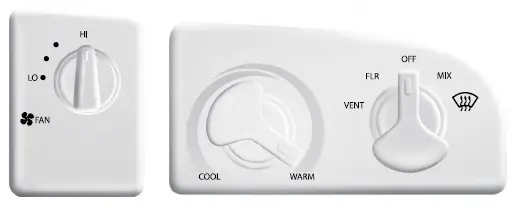
Note: Depending on your vehicle option package, the controls may look different from what you see here.
Directing the Air
Turn the control to direct the air.
- Direct air to the instrument panel air vents.
- Direct air to the footwell air vents.
- Direct air to the instrument panel and footwell air vents.
- Direct air to the windshield air vents. You can also use this setting to defog and clear the windshield of a thin covering of ice.
Setting the Blower Motor Speed Turn the control to adjust the volume of air circulated in the vehicle.
Turn the control to adjust the volume of air circulated in the vehicle.
Setting the Temperature
 Turn the control to set the temperature.
Turn the control to set the temperature.
Switching the Heater On and Off
![]() Turn the control.
Turn the control.
Manual Climate Control (If Equipped) 
Note: Depending on your vehicle option package, the controls may look different from what you see here.
Directing the Air
Turn the control to direct the air.
![]() Direct air to the instrument panel air vents.
Direct air to the instrument panel air vents.![]() Direct air to the footwell air vents.
Direct air to the footwell air vents.![]() Direct air to the instrument panel and footwell air vents.
Direct air to the instrument panel and footwell air vents.
Direct air to the windshield air vents. You can also use this setting to defog and clear the windshield of a thin covering of ice.
Switching the Air Conditioning On and Off Turn to switch the air conditioning on or off.
Turn to switch the air conditioning on or off.
Switching Maximum Air Conditioning On and Of![]() Turn the control for maximum cooling.
Turn the control for maximum cooling.
Recirculated air flows through the instrument panel vents and air conditioning turns on.
Setting the Blower Motor Speed![]() Turn the control to adjust the volume of air circulated in the vehicle.
Turn the control to adjust the volume of air circulated in the vehicle.
Setting the Temperature Turn the control to set the temperature.
Turn the control to set the temperature.
Switching the Climate Control On and Off![]() Turn the control.
Turn the control.
HINTS ON CONTROLLING THE INTERIOR CLIMATE
General Hints
Note: Prolonged use of recirculated air may cause the windows to fog up.
Note: You may feel a small amount of air from the footwell air vents regardless of the air distribution setting.
Note: To reduce humidity build-up inside your vehicle, do not drive with the system switched off or with recirculated air always switched on.
Note: To reduce fogging of the windshield during humid weather, adjust the air distribution control to the windshield air vents position.
Note: Do not place objects under the front seats as this may interfere with the airflow to the rear seats.
Note: Remove any snow, ice or leaves from the air intake area at the base of the windshield.
Note: To improve the time to reach a comfortable temperature in hot weather, drive with the windows open until you feel cold air through the air vents.
Quickly Heating the Interior
- Adjust the fan speed to the highest speed setting.
- Adjust the temperature control to the full heat setting.
- Direct air to the footwell air vents.
Recommended Settings for Heating
- Adjust the fan speed to the center setting.
- Adjust the temperature control to the midway point of the hot settings.
- Direct air to the footwell air vents.
Quickly Cooling the Interior
- Switch MAX A/C on.
- Drive with the windows open until you feel cold air through the air vents.
Recommended Settings for Cooling
- Adjust the fan speed to the center setting.
- Adjust the temperature control to the midway point of the cold settings.
- Direct air to the instrument panel air vents.
Read all Instructions for Climate Control User Guide
FORD E-350 2023 Auxiliary Power Points User Guide
2023 FORD E-350 Auxiliary Power Points And Engine Instructions
Auxiliary Power Points
12 Volt DC PowerPoint
WARNING: Do not plug optional electrical accessories into the cigar lighter socket. Incorrect use of the cigar lighter can cause damage not covered by the vehicle warranty and can result in fire or serious injury.
Note: When you switch the ignition on, you can use the socket to power 12-volt appliances with a maximum current rating of 15 amps.
Note: If the power supply does not work after you switch the ignition off, switch the ignition on.
Note: Do not hang any accessory from the accessory plug.
Note: Do not use the power point over the vehicle capacity of 12 volt DC 180 watts or a fuse may blow.
Note: Always keep the power point caps closed when not in use.
Do not insert objects other than an accessory plug into the PowerPoint. This damages the PowerPoint and may blow the fuse.
Run the vehicle for full capacity use of the PowerPoint.
To prevent the battery from running out of charge:
- Do not use the power point longer than necessary when the vehicle is not running.
- Do not leave devices plugged in overnight or when you park your vehicle for extended periods.
Locations
Power points could be in the following locations:
- On the instrument panel.
- Inside the glove box.
- Behind the driver’s seat, upper trim panel.
110 Volt AC Power Point (If Equipped)
WARNING: Do not keep electrical devices plugged into the power outlet whenever the device is not in use. The outlet provides power when the vehicle is on. Failure to follow this instruction could result in personal injury.
WARNING: Do not use an extension cord or connect multiple devices to the power outlet. Doing so could result in overloading the power outlet. Failure to follow this instruction could result in fire, personal injury or property damage.
Note: The powerpoint turns off when you switch the ignition off, or when the battery voltage drops below 11 volts.
You can use the power point for electric devices that require up to 150 watts. It is on the instrument panel. 
To gain access to the outlet contacts, press the plug against the outlet and rotate clockwise.
When the indicator light on the PowerPoint is:
- On: The power point is working, the ignition is on and a device is plugged in.
- Off: The PowerPoint is off, the ignition is off or no device is plugged in.
- Flashing: The power point is in fault mode.
The power outlet temporarily turns off power when in fault mode if the device exceeds the 150-watt limit. Unplug your device and switch the ignition off. Switch the ignition back on, but do not plug your device back in. Let the system cool off and switch the ignition off to reset the fault mode. Switch the ignition back on and make sure the indicator light remains on.
Do not use the power point for certain electric devices, including:
- Cathode-ray, tube-type televisions.
- Motor loads, such as vacuum cleaners, electric saws, and other electric power tools or compressor-driven refrigerators.
- Measuring devices, which process precise data, such as medical equipment or measuring equipment.
- Other appliances require an extremely stable power supply such as microcomputer-controlled electric blankets or touch-sensor lamps.
Starting and Stopping the Engine
GENERAL INFORMATION
WARNING: Extended idling at high engine speeds can produce very high temperatures in the engine and exhaust system, creating the risk of fire or other damage.
WARNING: Do not park, idle or drive your vehicle on dry grass or another dry ground cover. The emission system heats up the engine compartment and exhaust system, creating the risk of fire.
WARNING: Do not start the engine in a closed garage or in other enclosed areas. Exhaust fumes can be toxic. Always open the garage door before you start the engine.
WARNING: Exhaust leaks may result in the entry of harmful and potentially lethal fumes into the passenger compartment. If you smell exhaust fumes inside your vehicle, have your vehicle inspected immediately. Do not drive if you smell exhaust fumes.
If you disconnect the battery, your vehicle may exhibit some unusual driving characteristics for approximately 5 mi (8 km) after you reconnect it. This is because the engine management system must realign itself with the engine. You can disregard any unusual driving characteristics during this period.
Read all Instructions for Auxiliary Power Points User Guide
FORD E-350 2023 Fuel and Refueling User Guide
2023 Ford E-350 Fuel Refueling and Engine Emission Control Guidelines
Fuel and Refueling
Your vehicle is designed to operate on regular unleaded gasoline with a minimum pump (R+M)/2 octane rating of 87 or regular unleaded gasoline blended with a maximum of 85% ethanol (E85). Some fuel stations, particularly those in high-altitude areas, offer fuels posted as regular unleaded gasoline with an octane rating below 87. The use of these fuels could result in engine damage that will not be covered by the vehicle warranty. For the best overall vehicle and engine performance, premium fuel with an octane rating of 91 or higher is recommended. The performance gained by using premium fuel is most noticeable in hot weather as well as other conditions, for example, when towing a trailer. See Towing (page 129).
Do not be concerned if the engine sometimes knocks lightly. However, if the engine knocks heavily while using fuel with the recommended octane rating, contact an authorized dealer to prevent any engine damage.
We recommend Top Tier detergent gasoline, were available to help minimize engine deposits and maintain the optimal vehicle and engine performance. For additional information, refer to www.toptiergas.com.
Note: Use of any fuel for which the vehicle was not designed can impair the emission control system, cause loss of vehicle performance, and cause damage to the engine which may not be covered by the vehicle Warranty.
Do not use:
- Diesel fuel.
- Fuels containing kerosene or paraffin.
- Fuels containing more than 85% ethanol or E100 fuel.
- Fuels containing methanol.
- Fuels containing metallic-based additives, including manganese-based compounds.
- Fuels containing the octane booster additive, methylcyclopentadienyl manganese tricarbonyl (MMT).
- Leaded fuel, using leaded fuel is prohibited by law.
The use of fuels with metallic compounds such as methylcyclopentadienyl manganese tricarbonyl (commonly known as MMT), which is a manganese-based fuel additive, will impair engine performance and affect the emission control system.
Switching Between E85 and Gasoline
We do not recommend repeatedly alternating between E85 and gasoline. If you switch from using E85 to gasoline, or from gasoline to E85, add as much fuel as possible, at least half a tank. Drive your vehicle immediately for a minimum of 5 mi (8 km) to allow it to adapt to the change in ethanol concentration. If you use E85 exclusively, we recommend that you fill the fuel tank with regular unleaded gasoline at each scheduled oil change.
FUEL QUALITY – GASOLINE
Choosing the Right Fuel
Your vehicle is designed to operate on regular unleaded gasoline with a minimum pump (R+M)/2-octane rating of 87. Some fuel stations, particularly those in high-altitude areas, offer fuels posted as regular unleaded gasoline with an octane rating below 87. The use of these fuels could result in engine damage that will not be covered by the vehicle warranty. For best overall vehicle and engine performance, premium fuel with an octane rating of 91 or higher is recommended. The performance gained by using premium fuel is most noticeable in hot weather as well as other conditions, for example when towing a trailer. See Towing (page 129).
Do not be concerned if the engine sometimes knocks lightly. However, if the engine knocks heavily while using fuel with the recommended octane rating, contact
an authorized dealer to prevent any engine damage. We recommend Top Tier detergent gasoline, where available to help minimize engine deposits and maintain the optimal vehicle and engine performance. For additional information, refer to www.toptiergas.com.
Note: Use of any fuel for which the vehicle was not designed can impair the emission control system, cause loss of vehicle performance, and cause damage to the the engine which may not be covered by the vehicle Warranty.
Do not use:
- Diesel fuel.
- Fuels containing kerosene or paraffin.
- Fuel containing more than 15% ethanol or E85 fuel.
- Fuels containing methanol.
- Fuels containing metallic-based additives, including manganese-based compounds.
- Fuels containing the octane booster additive, methylcyclopentadienyl manganese tricarbonyl (MMT).
- Leaded fuel, using leaded fuel is prohibited by law.
The use of fuels with metallic compounds such as methylcyclopentadienyl manganese tricarbonyl (commonly known as MMT), which is a manganese-based fuel additive, will impair engine performance and affect the emission control system.
RUNNING OUT OF FUEL
Avoid running out of fuel. Running out of fuel can cause damage not covered by the vehicle Warranty.
If your vehicle runs out of fuel:
- Normally, adding 1.3 gal (5 L) of fuel is enough to restart the engine. If your vehicle is on a steep grade, more fuel may be required.
- You may need to cycle the ignition from off to on several times after refueling to allow the fuel system to pump the fuel from the tank to the engine. On restarting, cranking time will take a few seconds longer than normal.
Filling a Portable Fuel Container
WARNING: Flow of fuel through a fuel pump nozzle can produce static electricity. This can cause a fire if you are filling an ungrounded fuel container.
Use the following guidelines to avoid electrostatic charge build-up, which can produce a spark, when filling an ungrounded fuel container:
- Only use an approved fuel container to transfer fuel to your vehicle. Place the container on the ground when filling.
- Do not fill a fuel container while it is inside your vehicle (including the cargo area).
- Keep the fuel pump nozzle in contact with the fuel container while filling.
- Do not use a device that holds the fuel pump nozzle lever in the fill position.
REFUELING
WARNING: Fuel vapor burns violently and a fuel fire can cause severe injuries.
WARNING: Read and follow all the instructions on the pump island.
WARNING: When refueling always shut the engine off and never allow sparks or open flames near the fuel tank filler valve. Never smoke or use a cell phone while refueling. Fuel vapor is extremely hazardous under certain conditions. Avoid inhaling excess fumes.
WARNING: Stay outside your vehicle and do not leave the fuel pump unattended when refueling your vehicle.
WARNING: Keep children away from the fuel pump. Never let children pump fuel.
WARNING: Wait at least five seconds before removing the fuel pump nozzle to allow any residual fuel to drain into the fuel tank.
WARNING: Stop refueling after the fuel pump nozzle automatically shuts off for the second time. Failure to follow this will fill the expansion space in the fuel tank and could lead to fuel overflowing.
Read all Instructions for Fuel and Refueling User Guide
FORD E-350 2023 Transmission User Guide
2023 Ford E-350 Transmission Guidelines
AUTOMATIC TRANSMISSION
WARNING: Apply the parking brake, shift into a park (P), switch the ignition off, and remove the key before you leave your vehicle. Failure to follow this instruction could result in personal injury or death.
Putting your vehicle in or out of gear:
- Fully press down the brake pedal.
- Move the gearshift lever into the preferred gear.
- When you finish driving, come to a complete stop.
- Move the gearshift lever and securely latch it in the park (P).
- Release the brake pedal and the transmission remains in the selected gear.
Park (P)
This position locks the transmission and prevents the wheels from turning.
Reverse (R)
With the transmission in reverse (R), your vehicle moves backward. Always come to a complete stop before shifting into and out of reverse (R).
Neutral (N)
With the transmission in neutral (N), you can start your vehicle and it is free to roll. Hold the brake pedal down when in this position.
Drive (D)
Drive (D) is the normal driving position for the best fuel economy. The overdrive function allows automatic upshifts and downshifts through gears one through six.
Manual (M)
Moving the gearshift lever to the manual (M) position allows you to manually select the gear you prefer. Only the current gear displays. Use the buttons on the gearshift lever to manually select gears. Press the+ button to upshift or the – button to downshift. Return the transmission to a different gearshift position to deactivate manual control.
Second (2)
Transmission operates in the second (2) gear only. Use a second (2) gear to start up slippery roads.
First (1)
- Transmission operates in first (1) gear only.
- Provides maximum engine braking.
- Allows upshifts by moving the gearshift lever.
- Does not downshift into first (1) gear at high speeds; allows for first (1) gear when the vehicle reaches slower speeds.
Forced downshifts
- Allowed in drive (D) with the tow/haul feature on or off.
- Press the accelerator to the floor.
- Allows transmission to select an appropriate gear.
![]() Tow/Haul Mode
Tow/Haul Mode
To activate tow/haul, press the button on the gearshift lever.
The TOW HAUL indicator light illuminates in the instrument cluster.
The tow/haul feature:
- Delays upshift to reduce the frequency of transmission shifting.
- Provides engine braking in all forward gears, which slows your vehicle and assists you in controlling your vehicle when descending a slope. Depending on driving conditions and load conditions, may downshift the transmission, slow your vehicle and control your vehicle speed when descending a hill, without pressing the accelerator pedal. The amount of downshifting braking provided varies based on the amount you press the brake pedal.
The tow/haul feature improves transmission operation when towing a trailer or a heavy load. All transmission gear ranges are available when using tow/haul.
To deactivate the tow/haul feature and return to normal driving mode, press the button on the gearshift lever again. The TOW HAUL light deactivates. Tow/haul also deactivates when you power down your vehicle.
WARNING: Do not use tow/haul when the road surface is slippery. Failure to follow this instruction could result in the loss of control of your vehicle.
Understanding Your SelectShift Automatic™ Transmission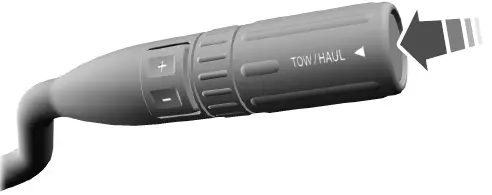
Note: When pressing the button on the gearshift lever, you can cycle through the available drive modes.
Your vehicle has a SelectShift Automatic™ transmission gearshift lever. The SelectShift Automatic transmission gives you the ability to change gears up or down without a clutch.
To prevent the engine from running at too low an RPM, which may cause it to stall, SelectShift still makes some downshifts if it has determined that you have not downshifted in time. Although SelectShift makes some downshifts for you, it still allows you to downshift at any time if the SelectShift determines that damage to the engine does not occur from over-revving.SelectShift does not upshift, even if the engine is approaching the RPM limit. Shift manually by pressing the + button.
Note: Engine damage may occur if you maintain excessive engine revving without shifting. SelectShift does not automatically upshift, even if the engine is approaching the RPM limit. Shift manually by pressing the (+) paddle.
Progressive Range Selection – PRS
(If Equipped)
Progressive Range Selection gives you the ability to lockout gears from the automatic shifting range. This may provide you with an improved driving experience. For example, in slippery conditions or when experiencing a steep grade.
With the gearshift lever in a drive (D), press the – button to activate PRS. The instrument cluster indicates the available and selected gears.
All available gears display with the current gear indicated. Press the – button again to lock out gears beginning with the highest gear. Example: press the – button twice to lock out 6th and 5th gears. Only the available gears are displayed, and the transmission automatically shifts between the available gears. Press the + button to unlock gears to allow the transmission to shift to higher gears. The transmission shifts within the gear range you select.
Automatic Transmission at a stop
(If Equipped)
Your transmission could reduce the load on the engine when the vehicle stops, and the gear selector is in a drive (D) to reduce fuel consumption and emissions. The transmission resumes operation when you release the brake. This feature activates when the transmission is sufficiently warmed, and the vehicle is on a level slope.
Automatic Transmission Adaptive Learning
This feature may increase durability and provide a consistent shift feel over the life of your vehicle. A new vehicle or transmission may have firm shifts, soft shifts, or both. This is normal and does not affect the function or durability of the transmission. Over time, the adaptive learning process fully updates transmission operation.
Brake-Shift Interlock
WARNING: Do not drive your vehicle until you verify that the stop lamps are working.
WARNING: When doing this procedure, you need to take the transmission out of the park (P) which means your vehicle can roll freely. To avoid unwanted vehicle movement, always fully apply the parking brake prior to doing this procedure. Use wheel chocks if appropriate.
WARNING: If the parking brake is fully released, but the brake warning lamp remains illuminated, the brakes may not be working properly. Have your vehicle checked as soon as possible Your vehicle has a brake-shift interlock feature that prevents the gearshift lever from moving from park (P) when the ignition is in the 3 (on) position and the brake pedal is not pressed.
FORD E-350 2023 Stability Control User Guide
FORD E-350 2023 Stability Control User Guide
Stability Control
PRINCIPLE OF OPERATION
WARNING: Vehicle modifications involving the braking system, aftermarket roof racks, suspension, steering system, tire construction, and wheel and tire size may change the handling characteristics of your vehicle and may adversely affect the performance of the electronic stability control system. In addition, installing any stereo loudspeakers may interfere with and adversely affect the electronic stability control system. Install any aftermarket stereo loudspeaker as far as possible from the front center console, the tunnel, and the front seats in order to minimize the risk of interfering with the electronic stability control sensors. Reducing the effectiveness of the electronic stability control system could lead to an increased risk of loss of vehicle control, vehicle rollover, personal injury, and death.
WARNING: Remember that even advanced technology cannot defy the laws of physics. It’s always possible to lose control of a vehicle due to inappropriate driver input for the conditions. Aggressive driving on any road condition can cause you to lose control of your vehicle increasing the risk of personal injury or property damage. Activation of the electronic stability control system is an indication that at least some of the tires have exceeded their ability to grip the road; this could reduce the operator’s ability to control the vehicle potentially resulting in a loss of vehicle control, vehicle rollover, personal injury, and death. If your electronic stability control system activates, SLOW DOWN.
The system automatically turns on each time you switch the ignition on. If a fault occurs in either the stability control or the traction control system, you may experience the following conditions:
- The stability and traction control light illuminate steadily.
- The stability control and traction control systems do not enhance your vehicle’s ability to maintain traction on the wheels.
If a driving condition activates either the stability control or the traction control system you may experience the following conditions:
- The stability and traction control light flashes.
- Your vehicle slows down.
- Reduced engine power.
- A vibration in the brake pedal.
- The brake pedal is stiffer than usual.
- If the driving condition is severe and your foot is not on the brake, the brake pedal may move as the system applies higher brake force.
The stability control system has several features built into it to help you maintain control of your vehicle:
Electronic Stability Control
The system enhances your vehicle’s ability to prevent skids or lateral slides by applying brakes to one or more of the wheels individually and, if necessary, reducing engine power.
Traction Control
The system enhances your vehicle’s ability to maintain traction of the wheels by detecting and controlling wheel spin. See Using Traction Control (page 103).

- A vehicle without stability control skidding off its intended route.
- B vehicle with stability control maintaining control on a slippery surface.
USING STABILITY CONTROL
The system automatically turns on each time you switch the ignition on.
You cannot switch the stability control system off, but when you shift into reverse (R), the system deactivates.
You can switch the traction control system off or on. See Using Traction Control (page 103).
Parking Aids
REARVIEW CAMERA
(IF EQUIPPED)
WARNING: The rearview camera system is a reverse aid supplement device that still requires the driver to use it in conjunction with the interior and exterior mirrors for maximum coverage.
WARNING: Objects that are close to either corner of the bumper or under the bumper, might not be seen on the screen due to the limited coverage of the camera system.
WARNING: Use caution when the rear cargo door is ajar. If the rear cargo door is ajar, the camera will be out of position and the video image could be incorrect. All guidelines disappear when the rear cargo door is ajar. Failure to follow this instruction could result in personal injury.
WARNING: Reverse your vehicle slowly. Failure to follow this instruction could result in the loss of control of your vehicle, personal injury or death.
WARNING: Use caution when turning camera features on or off when the transmission is not in park (P). Make sure your vehicle is not moving.
The rearview camera system provides a video image of the area behind your vehicle.
Example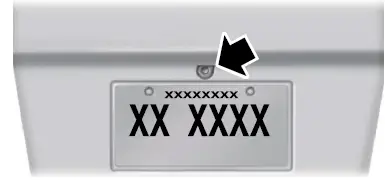
The camera is located on the rear of your vehicle.
Note: Camera location may vary depending on the configuration of your vehicle.
Using the Rear View Camera System
The rearview camera system displays what is behind your vehicle when you place the transmission in reverse (R).
Note: When towing, the camera only sees what you are towing behind your vehicle. This might not provide adequate coverage as it usually provides in normal operation and you might not see some objects.
The camera may not operate correctly under the following conditions:
- Mud, water or debris obstructs the camera’s view. Clean the lens with a soft, lint-free cloth and non-abrasive cleaner.
- The camera is misaligned due to damage to the rear of your vehicle.
Cruise Control
(If Equipped)
WHAT IS CRUISE CONTROL
Cruise control lets you maintain a set speed without keeping your foot on the accelerator pedal.
Requirements Use cruise control when the vehicle speed is greater than 20 mph (30 km/h).
Read all Instructions for Stability Control User Guide
FORD E-350 2023 Driving Aids User Guide
2023 FORD E-350 Driving Aids Instructions
DRIVER ALERT
WARNING: You are responsible for controlling your vehicle at all times. The system is designed to be an aid and does not relieve you of your responsibility to drive with due care and attention. Failure to follow this instruction could result in the loss of control of your vehicle, personal injury or death.
WARNING: The system may not function if the sensor is blocked.
WARNING: Take regular rest breaks if you feel tired. Do not wait for the system to warn you.
WARNING: Certain driving styles may result in the system warning you even if you are not feeling tired.
WARNING: In cold and severe weather conditions the system may not function. Rain, snow, and spray can all limit sensor performance.
WARNING: The system will not operate if the sensor cannot track the road lane markings.
WARNING: If damage occurs in the immediate area surrounding the sensor, have your vehicle checked as soon as possible.
WARNING: The system may not correctly operate if your vehicle is fitted with a suspension kit not approved by us.
Note: Keep the windshield free from obstructions. For example, bird droppings, insects, and snow or ice.
Note: If you have a blocked camera or damaged windshield, the system may not function.
Note: The system remembers the last setting when you start your vehicle unless it detects a MyKey™.
Note: If enabled in the menu, the system activates at speeds above 40 mph (64 km/h).  The system monitors your driving behavior using various inputs including the front camera sensor.
The system monitors your driving behavior using various inputs including the front camera sensor.
If the system detects reduced driving alertness below a certain threshold, the system alerts you using a tone and a message in the information display.
Using Driver Alert
Switching the system on and off
You may switch the system on or off through the information display by selecting Settings, Driver Assist and then Driver Alert in the menu. When activated, the system monitors your alertness level based on your driving behavior in relation to the lane markings and other factors.
System Warnings
Note: The system does not issue a warning
The warning system is in two stages. At first the system issues a temporary warning that you need to take a rest. This message only appears for a short time. If the system detects a further reduction in driving alertness, another warning could be issued which remains in the information display for a longer time. Press OK on the steering wheel control to clear the warning. When active the system runs in the background and only issues a warning if required.
Resetting the System
You can reset the system by either:
- Switching the ignition off and on.
- Stopping the vehicle and then opening and closing the driver’s door.
LANE-KEEPING SYSTEM
(IF EQUIPPED)
WARNING: You are responsible for controlling your vehicle at all times. The system is designed to be an aid and does not relieve you of your responsibility to drive with due care and attention. Failure to follow this instruction could result in the loss of control of your vehicle, personal injury or death.
WARNING: Always drive with due care and attention when using and operating the controls and features on your vehicle.
WARNING: In cold and severe weather conditions the system may not function. Rain, snow and spray can all limit sensor performance.
WARNING: The system will not operate if the sensor cannot track the road lane markings.
WARNING: The sensor may incorrectly track lane markings as other structures or objects. This can result in a false or missed warning.
WARNING: Large contrasts in outside lighting can limit sensor performance.
WARNING: The system may not operate properly if the sensor is blocked. Keep the windshield free from obstruction.
WARNING: If damage occurs in the immediate area surrounding the sensor, have your vehicle checked as soon as possible.
WARNING: The system may not correctly operate if your vehicle is fitted with a suspension kit not approved by us.
Note: The system works as long as the camera can detect one lane marking at a speed above 40 mph (64 km/h).
Note: The system may not function with a blocked camera, or if the windshield is damaged or dirty. 
When you switch the system on and it detects an unintentional drift out of your lane is likely to occur, the system notifies or assists you to stay in your lane through the steering system and information display. The system provides a warning by an audible tone.
Switching the System On and Off
Note: The system on or off setting is stored until it is manually changed unless a MyKey is detected. If the system detects a MyKey, it defaults to on and the mode is set to alert.
Note: If a MyKey is detected, pressing the button does not affect the on or off status of the system. You can only change the mode and sensitivity settings.
 Press the button to switch the system on or off. The button is above the audio unit or on the center console.
Press the button to switch the system on or off. The button is above the audio unit or on the center console.
System Settings
The system sensitivity and intensity can be adjusted through the display screen. See General Information (page 65). The system remembers the last selection. You do not need to readjust the setting each time you turn on your vehicle.
Sensitivity: This setting allows you to select where in the lane a warning is provided. Increasing the sensitivity setting moves the warning zones in closer to your vehicle.
- A Normal
- B Increased
Note: The alert diagram illustrates general zone coverage. It does not provide exact zone parameters.
System Display 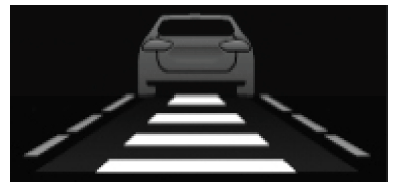
When you switch on the system, a graphic with lane markings appears in the display screen.
Note: The overhead vehicle graphic may still display if adaptive cruise control is enabled.
While the system is on, the color of the lane markings changes to indicate the system status.
Gray: Indicates that the system is temporarily unable to provide a warning on the indicated side(s). This may be because:
- Your vehicle is below the activation speed.
- The direction indicator is active.
- Your vehicle is in a dynamic maneuver.
- The road has no or poor lane markings in the camera’s field of view.
- The camera is obscured or unable to detect the lane markings due to environmental, traffic or vehicle conditions. For example, significant sun angles, shadows, snow, heavy rain or fog, following a large vehicle that is blocking or shadowing the lane, or poor headlamp illumination.
See Troubleshooting for additional information.
Green: Indicates that the system is available or ready to provide a warning on the indicated side(s).
Red: Indicates that the system is providing or has just provided a lane-keeping alert warning.
You can temporarily disable the system at any time by doing the following:
- Quick braking.
- Fast acceleration.
- Using your direction indicator.
- Evasive steering maneuver.
- Driving too close to the lane markings.
Read all Instructions for Driving Aids User Guide
FORD E-350 2023 Load Carrying User Guide
2023 FORD E-350 Load Carrying Guidelines
LOAD LIMIT
Vehicle Loading – with and without a Trailer
This section guides you in the proper loading of your vehicle, trailer, or both. Keep your loaded vehicle weight within its design rating capability, with or without a trailer. Properly loading your vehicle provides a maximum return on vehicle design performance. Before you load your vehicle, become familiar with the following terms for determining your vehicle’s weight rating, with or without a trailer, from the vehicle’s Tire and Loading Information label or Safety Compliance Certification label.
Tire and Loading Label Information Example:

Payload
Payload is the combined weight of cargo and passengers that your vehicle is carrying. The maximum payload for your vehicle appears on the Tire and Loading label. The label is either on the B-pillar or the edge of the driver’s door. Vehicles exported outside the US and Canada may not have a tire and loading label. Look for “The combined weight of occupants and cargo should never exceed XXX kg OR XXX lb” for maximum payload. The payload listed on the Tire and Loading Information label is the maximum payload for your vehicle as built by the assembly plant. If you install any additional equipment on your vehicle, you must determine the new payload. Subtract the weight of the equipment from the payload listed on the Tire and Loading label. When towing, trailer tongue weight or kingpin weight is also part of the payload.
WARNING: The appropriate loading capacity of your vehicle can be limited either by volume capacity (how much space is available) or by payload capacity (how much weight the vehicle should carry). Once you have reached the maximum payload of your vehicle, do not add more cargo, even if there is space available. Overloading or improperly loading your vehicle can contribute to loss of vehicle control and vehicle rollover.
GAWR (Gross Axle Weight Rating)
GAWR is the maximum allowable weight that a single axle (front or rear) can carry. These numbers are on the Safety Compliance Certification label. The label is located on the door hinge pillar, door-latch post, or the door edge that meets the door-latch post, next to the driver seating position. The total load on each axle must never exceed its Gross Axle Weight Rating.
GVWR (Gross Vehicle Weight Rating)
GVWR is the maximum allowable weight of the fully-loaded vehicle. This includes all options, equipment, passengers, and cargo. It appears on the Safety Compliance Certification label. The label is located on the door hinge pillar, door-latch post, or the door edge that meets the door-latch post, next to the driver seating position.
The gross vehicle weight must never exceed the Gross Vehicle Weight Rating.
Safety Compliance Certification Label Example:
WARNING: Exceeding the Safety Compliance Certification label vehicle weight limits can adversely affect the performance and handling of your vehicle, causing vehicle damage and can result in the loss of control of your vehicle, serious personal injury, or death.
Maximum Loaded Trailer Weight
Maximum loaded trailer weight is the highest possible weight of a fully loaded trailer the vehicle can tow. Consult an authorized dealer (or the RV and Trailer Towing Guide available at an authorized dealer) for more detailed information.
GCWR (Gross Combined Weight Rating)
GCWR is the maximum allowable weight of the vehicle and the loaded trailer, including all cargo and passengers, that the vehicle can handle without risking damage. (Important: The towing vehicle’s braking system is rated for operation at Gross Vehicle Weight Rating, not at Gross Combined Weight Rating.) Separate functional brakes should be used for safe control of towed vehicles and for trailers where the Gross Combined Weight of the towing vehicle plus the trailer exceeds the Gross Vehicle Weight Rating of the towing vehicle.
The gross combined weight must never exceed the Gross Combined Weight Rating.
Note: For trailer towing information refer to the RV and Trailer Towing Guide available at an authorized dealer.
WARNING: Do not exceed the GVWR or the GAWR specified on the certification label.
WARNING: Do not use replacement tires with lower load-carrying capacities than the original tires because they may lower your vehicle’s GVWR and GAWR limitations. Replacement tires with a higher limit than the original tires do not increase the GVWR and GAWR limitations.
WARNING: Exceeding any vehicle weight rating can adversely affect the performance and handling of your vehicle, causing vehicle damage, and can result in the loss of control of your vehicle, serious personal injury, or death.
Steps for determining the correct load limit:
- Locate the statement “The combined weight of occupants and cargo should never exceed XXX kg or XXX lb.” on your vehicle’s placard.
- Determine the combined weight of the driver and passengers that will be riding in your vehicle.
- Subtract the combined weight of the driver and passengers from XXX kg or XXX lb.
- The resulting figure equals the available amount of cargo and luggage load capacity. For example, if the “XXX” amount equals 1,400 lb. and there will be five 150 lb. passengers in your vehicle, the amount of available cargo and luggage load capacity is 650 lb. (1400-750 (5 x 150) = 650 lb.)
- Determine the combined weight of luggage and cargo being loaded on the vehicle. That weight may not safely exceed the available cargo and luggage load capacity calculated in Step 4.
- If your vehicle will be towing a trailer, the load from your trailer will be transferred to your vehicle. Consult this manual to determine how this reduces the available cargo and luggage load capacity of your vehicle.
Helpful examples for calculating the available amount of cargo and luggage load capacity
Suppose your vehicle has a 1400-pound (635-kilogram) cargo and luggage capacity. You decide to go golfing. Is there enough load capacity to carry you, four of your friends, and all the golf bags? You and four friends average 220 pounds (99 kilograms) each and the golf bags weigh approximately 30 pounds (13.5 kilograms) each. The calculation would be: 1400 -(5 x 220) – (5 x 30) = 1400 – 1100 – 150 = 150 pounds. Yes, you have enough load capacity in your vehicle to transport four friends and your golf bags. In metric units, the calculation would be: 635 kilograms – (5 x 99 kilograms) -(5 x 13.5 kilograms) = 635 – 495 -67.5 = 72.5 kilograms.
Suppose your vehicle has a 1400-pound (635-kilogram) cargo and luggage capacity. You and one of your friends decide to pick up cement from the local home improvement store to finish that patio you have been planning for the past two years. Measuring the inside of the vehicle with the rear seat folded down, you have room for twelve 100-pound (45-kilogram) bags of cement.
Do you have enough load capacity to transport the cement to your home? If you and your friend each weigh 220 pounds (99 kilograms), the calculation would be 1400 -(2 x 220) – (12 x 100) = 1400 – 440 – 1200 = – 240 pounds. No, you do not have enough cargo capacity to carry that much weight. In metric units, the calculation would be: 635 kilograms – (2 x 99 kilograms) – (12 x 45 kilograms) = 635 – 198 – 540 = -103 kilograms. You will need to reduce the load weight by at least 240 pounds (104 kilograms). If you remove three 100-pound (45-kilogram) cement bags, then the load calculation would be:1400 – (2 x 220) – (9 x 100) = 1400 – 440 -900 = 60 pounds. Now you have the load capacity to transport the cement and your friend home. In metric units, the calculation would be: 635 kilograms – (2 x 99 kilograms) – (9 x 45 kilograms) = 635 – 198 – 405 = 32 kilograms.
The above calculations also assume that the loads are positioned in your vehicle in a manner that does not overload the front or the rear gross axle weight rating specified for your vehicle on the Safety Compliance Certification label.
Special Loading Instructions for Owners of Pick-up Trucks and Utility-type Vehicles
WARNING: When loading the roof racks, we recommend you evenly distribute the load, as well as maintain a low center of gravity. Loaded vehicles, with higher centers of gravity, may handle differently than unloaded vehicles. Take extra precautions, such as slower speeds and increased stopping distance, when driving a heavily loaded vehicle.
Read all Instructions for Load Carrying User Guide
FORD E-350 2023 Towing User Guide
2023 FORD E-350 Towing System Guidelines
TOWING A TRAILER
WARNING: Do not exceed the GVWR or the GAWR specified on the certification label.
WARNING: Towing trailers beyond the maximum recommended gross trailer weight exceeds the limit of your vehicle and could result in engine damage, transmission damage, structural damage, loss of vehicle control, vehicle rollover and personal injury. Your vehicle may have electrical items, for example, fuses or relays, related to towing. See Fuses (page 152).
Your vehicle’s load capacity designation is by weight, not by volume, so you cannot necessarily use all available space when loading your vehicle.
Towing a trailer places an extra load on your vehicle’s engine, transmission, axle, brakes, tires and suspension. Inspect these components periodically during, and after, any towing operation.
Load Placement
To help minimize how trailer movement affects your vehicle when driving:
- Load the heaviest items closest to the trailer floor.
- Load the heaviest items centered between the left and right side trailer tires.
- Load the heaviest items above the trailer axles or just slightly forward toward the trailer tongue. Do not allow the final trailer tongue weight to go above or below 10-15% of the loaded trailer weight.
- Select a drawbar with the correct rise or drop. When both the loaded vehicle and trailer are connected, the trailer frame should be level, or slightly angled down toward your vehicle, when viewed from the side.
When driving with a trailer or payload, a slight takeoff vibration or shudder may be present due to the increased payload weight. Additional information regarding correct trailer loading and setting your vehicle up for towing is located in another chapter of this Owner’s Manual. See Load Limit (page 124). You can also find the information in the RV & Trailer Towing Guide. See an authorized dealer.
RECOMMENDED TOWING WEIGHTS
| Market | Website |
| United States of America | https://www.fleet.ford.com/ towing-guides/ |
| Canada | https://www.fleet.ford.ca/towing- guides/ |
ESSENTIAL TOWING CHECKS
Follow these guidelines for safe towing:
- Do not tow a trailer until you drive your vehicle at least 1,000 mi (1,600 km).
- Consult your local motor vehicle laws for towing a trailer.
- See the instructions included with towing accessories for the proper installation and adjustment specifications.
- Service your vehicle more frequently if you tow a trailer. See your scheduled maintenance information. See Scheduled Maintenance (page 247).
- If you use a rental trailer, follow the instructions the rental agency gives you.
See Load limits in the Load Carrying chapter for load specification terms found on the tire label and Safety Compliance label and instructions on calculating your vehicle’s load.
Remember to account for the trailer tongue weight as part of your vehicle load when calculating the total vehicle weight.
Trailer Towing Connector 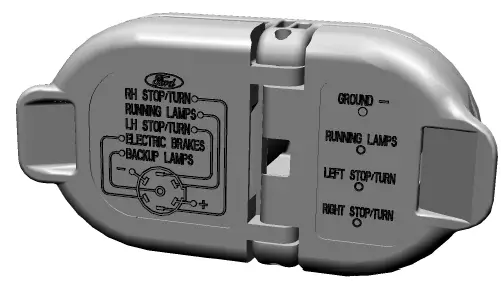
When attaching the trailer wiring connector to your vehicle, only use a proper fitting connector that works with the vehicle and trailer functions. Some seven-position connectors may have the SAE J2863 logo, which confirms that it is the proper wiring connector and works correctly with your vehicle.
| Color | Function |
| Yellow | Left turn signal and stop lamp |
| White | Ground (-) |
| Blue | Electric brakes |
| Green | Right turn signal and stop lamp |
| Orange | Battery (+) |
| Brown | Running lights |
| Grey | Reverse lights |
Hitches
Do not use a hitch that either clamps onto the bumper or attaches to the axle. You must distribute the load in your trailer so that 10-15% of the total weight of the trailer is on the tongue.
Weight-distributing Hitches
WARNING: Do not adjust the spring bars so that your vehicle’s rear bumper is higher than before attaching the trailer. Doing so will defeat the function of the weight-distributing hitch, which may cause unpredictable handling, and could result in serious personal injury. When connecting a trailer using a weight-distributing hitch, always use the following procedure:
- Park the loaded vehicle, without the trailer, on a level surface.
- Measure the height to the top of your vehicle’s front wheel opening on the fender. This is H1.
- Attach the loaded trailer to your vehicle without the weight-distributing bars connected.
- Measure the height to the top of your vehicle’s front wheel opening on the fender a second time. This is H2.
- Install and adjust the tension in the weight-distributing bars so that the height of your vehicle’s front wheel opening on the fender is approximately halfway down from H2, toward H1.
- Check that the trailer is level or slightly nose down toward your vehicle. If not, adjust the ball height accordingly and repeat Steps 2-6.
When the trailer is level or slightly nose down toward the vehicle:
- Lock the bar tension adjuster in place.
- Check that the trailer tongue securely attaches and locks onto the hitch.
- Install safety chains, lighting, and trailer brake controls as required by law or the trailer manufacturer.
Safety Chains
Note: Do not attach safety chains to the bumper.
Always connect the safety chains to the frame or hook retainers of your vehicle hitch.
To connect the safety chains, cross the chains under the trailer tongue and allow enough slack for turning tight corners. Do not allow the chains to drag on the ground.
Trailer Brakes
WARNING: Do not connect a trailer’s hydraulic brake system directly to your vehicle’s brake system. Your vehicle may not have enough braking power and your chances of having a collision greatly increase.
Electric brakes and manual, automatic, or surge-type trailer brakes are safe if you install them properly and adjust them to the manufacturer’s specifications. The trailer brakes must meet local and federal regulations.
The rating for the tow vehicle’s braking system operation is at the gross vehicle weight rating, not the gross combined weight rating.
Separate functioning brake systems are required for the safe control of towed vehicles and trailers weighing more than 1500 lb (680 kg) when loaded.
Integrated Trailer Brake Controller (If Equipped)
WARNING: Use the integrated trailer brake controller to properly adjust the trailer brakes and check all connections before towing a trailer. Failure to follow this instruction could result in the loss of control of your vehicle, personal injury or death.
Read all Instructions for Towing User Guide
FORD E-350 2023 Driving Hints User Guide
2023 FORD E-350 Driving Hints Guidelines
REDUCED ENGINE PERFORMANCE
WARNING: If you continue to drive your vehicle when the engine is overheating, the engine could stop without warning. Failure to follow this instruction could result in the loss of control of your vehicle.
If the engine coolant temperature gauge needle moves to the upper limit position, the engine is overheating. See Gauges (page 59).
You must only drive your vehicle for a short distance if the engine overheats. The distance you can travel depends on ambient temperature, vehicle load and terrain. The engine continues to operate with limited power for a short period of time.
If the engine temperature continues to rise, the fuel supply to the engine reduces. The air conditioning switches off and the engine cooling fan operates continually.
- Gradually reduce your speed and stop your vehicle as soon as it is safe to do so.
- Immediately switch the engine off to prevent severe engine damage.
- Wait for the engine to cool down.
- Check the coolant level. See Engine Coolant Check (page 166).
- Have your vehicle checked as soon as possible.
ECONOMICAL DRIVING
Fuel economy is affected by several things such as how you drive, the conditions you drive under and how you maintain your vehicle. There are some things to keep in mind that may improve your fuel economy:
- Accelerate and slow down in a smooth, moderate fashion.
- Drive at steady speeds.
- Anticipate stops; slowing down may eliminate the need to stop.
- Combine errands and minimize stop-and-go driving (When running errands, go to the furthest destination first and then work your way back home).
- Close the windows for high-speed driving.
- Drive at reasonable speeds.
- Keep the tires properly inflated and use only the recommended size.
- Use the recommended engine oil.
- Perform all regularly scheduled maintenance.
There are also some things you may want to avoid doing because they reduce your fuel economy: - Avoid sudden or hard accelerations.
- Avoid revving the engine before turning off the car.
- Avoid long idle periods.
- Do not warm up your vehicle on cold mornings.
- Reduce the use of air conditioning and heat.
- Avoid using speed control in hilly terrain.
- Do not rest your foot on the brake pedal while driving.
- Avoid carrying unnecessary weight.
- Avoid adding particular accessories to your vehicle (e.g. bug deflectors, rollbars/light bars, running boards, ski racks).
- Avoid driving with the wheels out of alignment.
BREAKING-IN
You need to break in new tires for approximately 300 mi (480 km). During this time, your vehicle may exhibit some unusual driving characteristics.
Avoid driving too fast during the first 1,000 mi (1,600 km). Vary your speed frequently and change up through the gears early. Do not labor the engine.
Do not tow during the first 1,000 mi
(1,600 km).
DRIVING THROUGH WATER
WARNING: Do not drive through flowing or deep water as you may lose control of your vehicle.
Note: Driving through standing water can cause vehicle damage.
Note: Engine damage can occur if water enters the air filter.
Before driving through standing water, check the depth. Never drive through water that is higher than the bottom of the wheel hubs. 
When driving through standing water, drive very slowly and do not stop your vehicle. Your brake performance and traction may be limited. After driving through water and as soon as it is safe to do so:
- Lightly press the brake pedal to dry the brakes and to check that they work.
- Check that the horn works.
- Check that the exterior lights work.
- Turn the steering wheel to check that the steering power assist works.
FLOOR MATS
WARNING: Use a floor mat designed to fit the footwell of your vehicle that does not obstruct the pedal area. Failure to follow this instruction could result in the loss of control of your vehicle, personal injury, or death.
Read all Instructions for Driving Hints User Guide
FORD E-350 2023 Customer Assistance User Guide
FORD E-350 2023 Customer Assistance User Guide
GETTING THE SERVICES YOU NEED
Warranty repairs to your vehicle must be performed by an authorized dealer. While any authorized dealer handling your vehicle line will provide warranty service, we recommend you return to your selling authorized dealer who wants to ensure your continued satisfaction.
Please note that certain warranty repairs require special training and equipment, so not all authorized dealers are authorized to perform all warranty repairs. This means that, depending on the warranty repair needed, you may have to take your vehicle to another authorized dealer.
A reasonable time must be allowed to perform a repair after taking your vehicle to the authorized dealer. Repairs will be made using Ford or Motorcraft® parts, or remanufactured or other parts that are authorized by Ford.
Away From Home
If you are away from home when your vehicle needs service, contact the Ford Customer Relationship Center or use the online resources listed below to find the nearest authorized dealer.
In the United States:
Mailing address
Ford Motor Company
Customer Relationship Center
P.O. Box 6248
Dearborn, MI 48126
Telephone
1-800-392-3673 (FORD)
(TDD for the hearing impaired:
1-800-232-5952)
If your vehicle is configured as a motorhome please call 1-800-444-3311 for support.
Additional information and resources are available online:
Website www.ford.com/support
These are some of the items that can be found online:
- U.S. dealer locator by Dealer Name, City/State or Zip Code.
- Owner Manuals.
- Maintenance Schedules.
- Recalls.
- Ford Extended Service Plans.
- Ford Genuine Accessories.
- Service specials and promotions. In Canada:
Mailing address
Customer Relationship Centre
Ford Motor Company of Canada, Limited P.O. Box 2000
Oakville, Ontario L6K 0C8
Telephone
1-800-565-3673 (FORD)
(TDD for the hearing impaired: 1-888-658-6805)
Website www.ford.ca
Facebook
FordServiceCA (English) FordServiceQC (Français)
Twitter
@FordServiceCA
Additional Assistance
If you have questions or concerns or are unsatisfied with the service you are receiving, follow these steps:
- Contact your Sales Representative or Service Advisor at your selling or servicing authorized dealer.
- If your inquiry or concern remains unresolved, contact the Sales Manager, Service Manager or Customer Relations Manager.
- If you require assistance or clarification on Ford Motor Company policies, please contact the Ford Customer Relationship Center.
In order to help us serve you better, please have the following information available when contacting a Customer Relationship Center:
- Vehicle Identification Number.
- Your telephone number (home and business).
- The name of the authorized dealer and city were located.
- The vehicle’s current odometer reading.
In some states within the United States, you must directly notify Ford in writing before pursuing remedies under your state’s warranty laws, and Ford is also allowed a final repair attempt.
Additionally, in some states within the United States, a consumer has the option of submitting a warranty dispute to the BBB Auto Line before taking action under the Magnuson-Moss Warranty Act, or to the extent allowed by state law, before pursuing replacement or repurchase remedies provided by certain state laws. This dispute handling procedure is not required prior to enforcing state-created rights or other rights which are independent of the Magnuson-Moss Warranty Act or state replacement or repurchase laws.
IN CALIFORNIA (U.S. ONLY)
California Civil Code Section 1793.2(d) requires that, if a manufacturer or its representative is unable to repair a motor vehicle to conform to the vehicle’s applicable express warranty after a reasonable number of attempts, the manufacturer shall be required to either replace the vehicle with one substantially identical or repurchase the vehicle and reimburse the buyer in an amount equal to the actual price paid or payable by the consumer (less a reasonable allowance for consumer use). The consumer has the right to choose whether to receive a refund or a replacement vehicle.
California Civil Code Section 1793.22(b) presumes that the manufacturer has had a reasonable number of attempts to conform the vehicle to its applicable express warranties if, within the first 18 months of ownership of a new vehicle or the first 18,000 mi (29,000 km), whichever occurs first:
- Two or more repair attempts are made on the same non-conformity likely to cause death or serious bodily injury OR
- Four or more repair attempts are made on the same nonconformity (a defect or condition that substantially impairs the use, value or safety of the vehicle) OR
- The vehicle is out of service for repair of nonconformities for a total of more than 30 calendar days (not necessarily all at one time).
In the case of 1 or 2 above, the consumer must also notify the manufacturer of the need for the repair of the nonconformity at the following address:
Ford Motor Company
16800 Executive Plaza Drive
Mail Drop 3NE-B
Dearborn, MI 48126
You are required to submit your warranty dispute to BBB AUTO LINE before asserting in court any rights or remedies conferred by California Civil Code Section 1793.22(b). You are also required to use BBB AUTO LINE before exercising rights or seeking remedies created by the Federal Magnuson-Moss Warranty Act, 15 U.S.C. sec. 2301 et seq. If you choose to seek redress by pursuing rights and remedies not created by California Civil Code Section 1793.22(b) or the Magnuson-Moss Warranty Act, resort to BBB AUTO LINE is not required by those statutes.
THE BETTER BUSINESS BUREAU (BBB) AUTO LINE PROGRAM (U.S. ONLY)
Your satisfaction is important to Ford Motor Company and to your dealer. If a warranty concern has not been resolved using the three-step procedure outlined earlier in this chapter in the Getting the Services you need section, you may be eligible to participate in the BBB AUTO LINE program.
The BBB AUTO LINE program consists of two parts – mediation and arbitration. During mediation, a representative of the BBB will contact both you and Ford Motor Company to explore options for settlement of the claim. If an agreement is not reached during mediation or you do not want to participate in mediation, and if your claim is eligible, you may participate in the arbitration process. An arbitration hearing will be scheduled so that you can present your case in an informal setting before an impartial person. The arbitrator considers the testimony provided and makes a decision after the hearing.
Disputes submitted to the BBB AUTO LINE program are usually decided within 40 days after you file your claim with the BBB. You are not bound by the decision and may reject the decision and proceed to court where all findings of the BBB Auto Line dispute, and decision, are admissible in the court action. Should you choose to accept the BBB AUTO LINE decision, Ford is then bound by the decision and must comply with the decision within 30 days of receipt of your acceptance letter.
BBB AUTO LINE Application: Using the information that follows, please call or write to request a program application. You will be asked for your name and address, general information about your new vehicle, information about your warranty concerns, and any steps you have already taken to try to resolve them. A Customer Claim Form will be mailed that needs to be completed, signed and returned to the BBB along with proof of ownership. Upon receipt, the BBB reviews the claim for eligibility under the Program Summary Guidelines.
Read all Instructions for Customer Assistance User Guide
FORD E-350 2023 Fuses And Maintenance User Guide
2023 FORD E-350 Fuses Types | Engine And Maintenance
FUSE SPECIFICATION CHART
Engine Compartment Fuse Box
WARNING: Always disconnect the battery before servicing high-current fuses.
WARNING: To reduce the risk of electrical shock, always replace the cover to the power distribution box before reconnecting the battery or refilling fluid reservoirs.
Note: If your vehicle has dual batteries, disconnecting the primary under-hood battery does not remove power from all circuits.
The engine compartment fuse box is in the engine compartment. It has high-current fuses that protect your vehicle’s main electrical systems from overloads.
If you disconnect and reconnect the battery, you need to reset some features. See Changing the 12V Battery (page 174).
Replace fuses with the same type and rating. See Changing a Fuse (page 160). 
| Item | Rating | Protected Component |
| 1 | 20 A | Horn. |
| 2 | 50 A | Blower motor. |
| 3 | — | Not used. |
| 4 | 30 A | Starter relay. |
| 5 | — | Not used. |
| 6 | 20 A | Upfitter relay 4 (cutaway). Not used (spare) (stripped chassis). |
| 8 | — | Not used. |
| 10 | — | Not used. |
| 12 | 20 A | Power point 4. |
| 13 | 10 A | Yaw sensor (stripped chassis).
Not used (spare) (cutaway). |
| 14 | 10 A | Forward looking radar (cutaway).
Not used (spare) (stripped chassis). |
| 15 | — | Not used. |
| 16 | — | Not used. |
| 17 | 10 A | Powertrain control module run/start feed. |
| 18 | 10 A | Anti-lock brake system run/ start feed. |
| 19 | — | Not used. |
| 20 | 30 A | Wiper power. |
| 21 | — | Not used. |
| 22 | 10 A | Wiper module (stripped chassis).
Not used (spare) (cutaway). |
| 23 | — | Not used. |
| Item | Rating | Protected Component |
| 24 | 40 A | Body control module – run power in feed 2. |
| 25 | 50 A | Body control module – run power in feed 1. |
| 26 | — | Not used. |
| 27 | 20 A | Body builder frame connector. |
| 28 | — | Not used. |
| 29 | 10 A | B+ power 12 V(special order vehicle). |
| 30 | 30 A | Power driver seat (cutaway).
Not used (spare) (stripped chassis). |
| 31 | — | Not used. |
| 32 | 20 A | Vehicle power 1. |
| 33 | 20 A | Vehicle power 2. |
| 34 | 10 A | Vehicle power 3. |
| 35 | 20 A | Vehicle power 4. |
| 36 | — | Not used. |
| 37 | — | Not used. |
| 38 | 10 A | Washer relay (stripped chassis).
Not used (spare) (cutaway). |
| 39 | — | Not used. |
| 41 | 30 A | Trailer brake control connector. |
| 43 | 30 A | Instrument panel connector (stripped chassis).
Not used (spare) (cutaway). |
| 45 | — | Not used. |
| 46 | 10 A | A/C clutch. |
| Item | Rating | Protected Component |
| 47 | 40 A | Upfitter relay 1 (cutaway). Not used (spare) (stripped chassis). |
| 48 | — | Not used. |
| 49 | 30 A | Pump electronics module. |
| 50 | 15 A | Fuel injectors. |
| 51 | 20 A | Power point 1. |
| 52 | 50 A | Power at all times (PAAT) Aux AC prep on B-pillar vehicle connector (cutaway).
Not used (spare) (stripped chassis). |
| 53 | 30 A | Trailer tow park lamps. |
| 54 | 40 A | R/S feed on instrument panel connector. |
| 55 | 20 A | Upfitter 3 relay (cutaway). Not used (spare) (stripped chassis). |
| 56 | 20 A | Power point 2 prep B-pillar connector. |
| 58 | 5 A | USB smart charger. |
| 59 | 10 A | Park lamps 1 (special order vehicle). |
| 60 | — | Not used. |
| 61 | — | Not used. |
| 62 | — | Not used. |
| 63 | — | Not used. |
| 64 | — | Not used. |
| 65 | — | Not used. |
| 66 | — | Not used. |
| 67 | — | Not used. |
| Item | Rating | Protected Component |
| 69 | — | Not used. |
| 70 | 40 A | Inverter. |
| 71 | 30 A | Anti-lock brake system valves. |
| 72 | 10 A | Brake on and off switch. |
| 73 | — | Not used. |
| 74 | — | Not used. |
| 75 | — | Not used. |
| 76 | 60 A | Anti-lock brake system pump. |
| 77 | 30 A | Voltage quality module power – body control module. |
| 78 | 10 A | Trailer tow stoplamps. |
| 79 | — | Not used. |
| 80 | 10 A | Trailer tow backup lamps. |
| 81 | — | Not used. |
| 82 | 5 A | Upfitter switch (factory location for ignition power). |
| 83 | 5 A | Upfitter switch (optional location for power at all times). |
| 84 | — | Not used. |
| 85 | — | Not used. |
| 86 | — | Not used. |
| 87 | — | Not used. |
| 88 | — | Not used. |
| 89 | — | Not used. |
| 91 | 40 A | Hot at all times (HAAT) / B+PWR on B-pillar connector (cutaway). |
| Item | Rating | Protected Component |
| Battery power on instrument panel connector(stripped chassis). | ||
| 93 | 10 A | Park lamps 3 (special order vehicle). |
| 94 | 10 A | Park lamps 2 (special order vehicle). |
| 95 | 20 A | Stoplamp relay. |
| 96 | — | Not used. |
| 97 | 50 A | Battery power to Engine, B- pillar and instrument panel vehicle connectors. |
| 98 | 30 A | Trailer tow battery charge. |
| 99 | 40 A | Upfitter 2 relay (cutaway). Not used (spare) (stripped chassis). |
| 100 | — | Not used. |
| 101 | — | Not used. |
| 102 | — | Not used. |
| 103 | — | Not used. |
| 104 | — | Not used. |
| 105 | 15 A | Trailer tow right-hand and left-hand stop lamp and direction indicator relay power. |
Read all Instructions for Fuses And Maintenance User Guide
FORD E-350 2023 Vehicle Care User Guide
2023 FORD E-350 Vehicle Care | Cleaning Interior And Exterior
Vehicle Care
GENERAL INFORMATION
Your dealer has many quality products available to clean your vehicle and protect its finishes.
CLEANING PRODUCTS
Materials
For best results, use the following products or products of equivalent quality:
For additional information and assistance, we recommend that you contact an authorized dealer.
| Name | Specification |
| Motorcraft® Bug and Tar Remover, ZC-42 (U.S. & Canada) | |
| Motorcraft® Custom Bright Metal Cleaner, ZC-15 (U.S. & Canada) | ESR-M5B194-B |
| Motorcraft® Detail Wash, ZC-3-A (U.S. & Canada) | ESR-M14P4-A |
| Motorcraft® Engine Shampoo and Degreaser, ZC-20 (U.S.) | ESR-M14P3-A |
| Motorcraft® Engine Shampoo, CXC-66-A (Canada) | |
| Motorcraft® Premium Leather and Vinyl Cleaner, ZC-56 (U.S. & Canada) | |
| Motorcraft® Multi-Purpose Cleaner, CXC-101 (Canada) | |
| Motorcraft® Premium Windshield Wash Concentrate with Bitterant, ZC-32-B2 (U.S.) | WSS-M14P19-A |
| Motorcraft® Premium Quality Windshield Washer Fluid, CXC-37- F/M (Canada) | WSS-M14P19-A |
| Motorcraft® Professional Strength Carpet & Upholstery Cleaner, ZC-54 (U.S. & Canada) | |
| Motorcraft® Premium Glass Cleaner, CXC-100 (Canada) | ESR-M14P5-A |
| Motorcraft® Spot and Stain Remover, ZC-14 (U.S.) | |
| Motorcraft® Ultra-Clear Spray Glass Cleaner, ZC-23 (U.S.) | ESR-M14P5-A |
| Motorcraft® Wheel and Tire Cleaner, ZC-37-A (U.S. & Canada) |
CLEANING THE EXTERIOR
Wash your vehicle regularly with cool or lukewarm water and a neutral pH shampoo, we recommend Motorcraft Detail Wash.
- Never use strong household detergents or soap, for example, dishwashing or laundry liquid. These products can discolor and spot painted surfaces.
- Never wash your vehicle when it is hot to the touch, or during strong or direct sunlight.
- Dry your vehicle with a chamois or soft terry cloth towel to eliminate water spots.
- Immediately remove fuel spillages, bird droppings, insect deposits and road tar. These may cause damage to your vehicle’s paintwork or trim over time. We recommend Motorcraft Bug and Tar Remover.
- Remove any exterior accessories, for example antennas, before entering a car wash.
- When filling with AdBlue®, remove any residue on painted surfaces immediately.
Note: Suntan lotions and insect repellents can damage painted surfaces. If these substances come in contact with your vehicle, wash the affected area as soon as possible.
Cleaning the Exterior Precautions
Immediately remove fuel spillages, AdBlue residuals, bird droppings, insect deposits and road tar. These may cause damage to your vehicle’s paintwork or trim over time.
Remove any exterior accessories, for example antennas, before entering a car wash.
Cleaning the Exterior Lamps
Note: Do not scrape the exterior lamps lenses or use abrasives, alcoholic solvents or chemical solvents to clean them.
Note: Do not wipe the exterior lamps when they are dry.
Exterior Chrome Parts
- Apply a high quality-cleaning product to bumpers and other chrome parts. Follow the manufacturer’s instructions. We recommend Motorcraft Custom Bright Metal Cleaner.
- Do not apply the cleaning product to hot surfaces. Do not leave the cleaning product on chrome surfaces longer than the time recommended.
- Using non-recommended cleaners can result in severe and permanent cosmetic damage.
Note: Never use abrasive materials, for example, steel wool or plastic pads as they can scratch the chrome surface.
Note: Do not use chrome cleaner, metal cleaner or polish on wheels or wheel covers.
Exterior Plastic Parts
For routine cleaning, we recommend Motorcraft Detail Wash. If tar or grease spots are present, we recommend Motorcraft Bug and Tar Remover.
Stripes or Graphics (If Equipped)
Hand washing your vehicle is preferred however, pressure washing may be used under the following conditions:
- Do not use water pressure higher than 2,000 psi (14,000 kPa).
- Do not use water hotter than 179°F (82°C).
- Use a spray with a 40-degree wide spray angle pattern.
- Keep the nozzle at a 12 in (305 mm) distance and a 90-degree angle to your vehicle’s surface.
- Never wash or rinse the engine while it is hot or running; water in the running engine may cause internal damage.
- Never wash or rinse any ignition coil, spark plug wire or spark plug well, or the area in and around these locations.
- Cover the battery, power distribution box, and air filter assembly to prevent water damage when cleaning the engine.
CLEANING THE WINDOWS AND WIPER BLADES
Car wash chemicals and environmental fallout can result in windshield and wiper blade contamination. Dirty windshields and wipers will result in poor windshield wiper operation. Keep the windshield and wiper blades clean to maintain windshield wiper performance.
Read all Instructions for Vehicle Care User Guide
FORD E-350 2023 Wheels and Tires User Guide
2023 FORD E-350 Wheels and Tires | Technical Specifications
Wheels and Tires
GENERAL INFORMATION
Notice to Utility Vehicle, Van and Truck Owners
WARNING: Utility vehicles have a significantly higher rollover rate than other types of vehicles. To reduce the risk of serious injury or death from a rollover or other crash you must avoid sharp turns and abrupt maneuvers, drive at safe speeds for the conditions, keep tires properly inflated, never overload or improperly load your vehicle, and make sure every passenger is properly restrained.
WARNING: In a rollover crash, an unbelted person is significantly more likely to die than a person wearing a seat belt. All occupants must wear seat belts. Children and infants must use appropriate restraints to minimize the risk of injury or ejection.

Utility vehicles and trucks handle differently than passenger cars in the various driving conditions that are encountered on streets, highways and off-road. Utility vehicles and trucks are not designed for cornering at speeds as high as passenger cars any more than low-slung sports cars are designed to perform satisfactorily under off-road conditions.
How Your Vehicle Differs from Other Vehicles
Sport-utility vehicles, vans and trucks can differ from some other vehicles in a few noticeable ways. Your vehicle may be:

- Higher – to allow higher load-carrying capacity and to allow it to travel over rough terrain without getting hung up or damaging underbody components.
- Shorter – to give it the capability to approach inclines and drive over the crest of a hill without getting hung up or damaging underbody components. All other things held equal, a shorter wheelbase may make your vehicle quicker to respond to steering inputs than a vehicle with a longer wheelbase.
- Narrower – to provide greater maneuverability in tight spaces, particularly in off-road use.

E166373
As a result of the above dimensional differences, sport-utility vehicles, vans and trucks often will have a higher center of gravity and a greater difference in center of gravity between the loaded and unloaded condition.
These differences that make your vehicle so versatile also make it handle differently than an ordinary passenger car.
TIRE CARE
Information About Uniform Tire Quality Grading
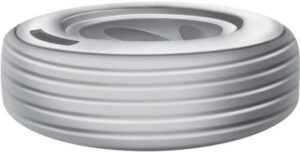
Tire Quality Grades apply to new pneumatic passenger car tires.
The Quality grades can be found where applicable on the tire sidewall between tread shoulder and maximum section width. For example: Treadwear 200
Traction AA Temperature A.
These Tire Quality Grades are determined by standards that the United States Department of Transportation has set.
Tire Quality Grades apply to new pneumatic passenger car tires.
They do not apply to deep tread, winter-type snow tires, space-saver or temporary use spare tires, light truck or LT type tires, tires with nominal rim diameters of 10 to 12 inches or
limited production tires as defined in Title 49 Code of Federal
Regulations Part 575.104 (c)(2).
U.S. Department of Transportation Tire quality
grades: The U.S. Department of Transportation requires Ford Motor Company to give you the following information about tire grades exactly as the government has written it.
Treadwear
The treadwear grade is a comparative rating based on the wear rate of the tire when tested under controlled conditions on a specified government test course. For example, a tire graded 150 would wear one and one-half (1 ½) times as well on the government course as a tire graded 100. The relative performance of tires depends upon the actual conditions of their use, however, and may depart significantly from the norm due to variations in driving habits, service practices, and differences in road characteristics and climate.
Traction AA A B C
WARNING: The traction grade assigned to this tire is based on straight-ahead braking traction tests and does not include acceleration, cornering, hydroplaning or peak traction characteristics.
The traction grades, from highest to lowest are AA, A, B, and C. The grades represent the tire’s ability to stop on wet pavement as measured under controlled conditions on specified government test surfaces of asphalt and concrete. A tire marked C may have poor traction performance.
Temperature A B C
WARNING: The temperature grade for this tire is established for a tire that is properly inflated and not overloaded. Excessive speed, underinflation, or excessive loading, either separately or in combination, can cause heat buildup and possible tire failure.
The temperature grades are A
(the highest), B and C, represent the tire’s resistance to the generation of heat and its ability to dissipate heat when tested under controlled conditions on a specified indoor laboratory test wheel. Sustained high temperature can cause the material of the tire to degenerate and reduce tire life, and excessive temperature can lead to sudden tire failure. Grade C corresponds to a level of performance that all passenger car tires must meet under the Federal Motor Vehicle Safety Standard No. 139. Grades B and A represent higher levels of performance on the laboratory test wheel than the minimum required by law.
Glossary of Tire Terminology
Tire label: A label showing the original equipment tire sizes, recommended inflation pressure and the maximum weight the vehicle can carry.
Tire Identification Number (TIN): A number on the sidewall of each tire providing information about the tire brand and manufacturing plant, tire size and date of manufacture. Also referred to as DOT code.
Inflation pressure: A measure of the amount of air in a tire.
Standard load: A class of P-metric or Metric tires designed to carry a maximum load at set pressure. For example: For
P-metric tires 35 psi (2.4 bar) and for Metric tires 36 psi (2.5 bar). Increasing the inflation pressure beyond this pressure does not increase the tire’s load carrying capability.
Extra load: A class of P-metric or Metric tires designed to carry a heavier maximum load at 42 psi (2.9 bar). Increasing the inflation pressure beyond this pressure does not increase the tire’s load-carrying capability.
kPa: Kilopascal, a metric unit of air pressure.
PSI: Pounds per square inch, a standard unit of air pressure.
Cold tire pressure: The tire pressure when the vehicle has been stationary and out of direct sunlight for an hour or more and prior to the vehicle being driven for 1.0 mi (1.6 km).
Read all Instructions for Wheels and Tires User Guide
FORD E-350 2023 Capacities, Specifications and Vehicle Identification User Guide
2023 FORD E-350 Vehicle Identification | Capacities And Specifications
Capacities and Specifications
ENGINE SPECIFICATIONS
| Engine | 7.3L V8 Engine |
| Displacement. | 445 in³ (7,293 cm³) |
| Required fuel. | Minimum 87 octane |
| Firing order. | 1-5-4-8-6-3-7-2 |
| Ignition system. | Coil near spark plug with spark plug wire |
| Spark plug gap. | 0.049 in (1.25 mm) – 0.053 in (1.35 mm) |
| Compression ratio. | 10.5:1 |
Drivebelt Routing
Single Alternator
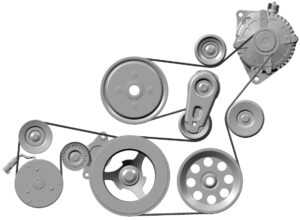 Drivebelt closest to the engine.
Drivebelt closest to the engine.- Drivebelt furthest from the engine.
Dual Alternator

- A Drivebelt closest to the engine.
- Drivebelt furthest from the engine.
MOTORCRAFT PARTS
| Component | Motorcraft Part number |
| Air filter element. | FA-2042 |
| One battery. | BXT-65-750 |
| Two batteries (optional). | BXT-65-750 |
| Component | Motorcraft Part number |
| Engine oil filter.1 | FL-820-S |
| Spark plug. | SP-589 |
| Transmission fluid filter. | FT-187 |
| Windshield wiper blade. | WW-2005 |
1 If a Motorcraft oil filter is not available, use an oil filter that meets industry performance specification SAE/USCAR-36.
We recommend Motorcraft parts that are available at your authorized dealer or at parts.ford.com. These parts are engineered for your vehicle, and meet or exceed our specifications. Use of other parts could impact vehicle performance, emissions and durability. Your warranty could be void for any damage related to use of other parts.
BULB SPECIFICATION CHART
Replacement bulbs are specified in the chart below. Headlamp bulbs must be marked with an authorized “D.O.T.” for
Exterior Lamps
North America and an “E” for Europe to ensure lamp performance, light brightness and pattern and safe visibility. The correct bulbs will not damage the lamp assembly or void the lamp assembly warranty and will provide quality bulb illumination time.
| Lamp | Trade Name |
| Front side marker lamp. | W5W |
| Park lamp. | 3157AK |
| Front direction indicator. | 3157AK |
| Headlamp low beam. | H13 |
| Headlamp high beam. | H13 |
| Front clearance lamp (exterior mirror). | 2825 |
| Brake, rear and direction indicator lamp. | 3157K |
| Reversing lamps. | 3156 |
Interior Lamps
| Lamp | Trade Name |
| Underhood Lamp. | 906 |
| Map lamp. | 578 |
| Dome lamp. | 578 |
| Cargo lamp. | 578 |
To replace all instrument panel lights – see your authorized dealer.
ENGINE OIL CAPACITY AND SPECIFICATION
Use oil that meets the defined specification and viscosity grade.
If you do not use oil that meets the defined specification and viscosity grade, it could result in:
- Component damage that your vehicle warranty does not cover.
- Longer engine cranking periods.
- Increased emission levels.
- Reduced vehicle performance.
- Reduced fuel economy.
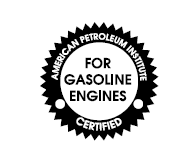
An oil that displays this symbol conforms to the current engine, emission system and fuel economy performance standards of ILSAC.
We recommend Motorcraft motor oil for your vehicle. If Motorcraft oil is not available, use motor oils of the recommended viscosity grade that display the API Certification Mark for gasoline engines.
Do not use supplemental engine oil additives because they are unnecessary and could lead to engine damage that your vehicle warranty does not cover.
Read all Instructions for Capacities, Specifications and Vehicle Identification User Guide
FORD E-350 2023 Connected Vehicle and Audio System User Guide
2023 FORD E-350 Connected Vehicle And Audio System Guideline
CONNECTED VEHICLE REQUIREMENTS
Connected service and related feature functionality requires a compatible vehicle network.
Some remote features require additional service activation. Log in to your Ford account for details. Some restrictions, third party terms and message or data rates may apply.
CONNECTED VEHICLE LIMITATIONS
Evolving technology, cellular networks, or regulations could affect functionality and availability, or continued provision of some features. These changes could even stop some features from functioning.
CONNECTING THE VEHICLE TO A MOBILE NETWORK WHAT IS THE MODEM
The modem allows access to a range of features built into your vehicle.
ENABLING AND DISABLING THE MODEM
- Press Settings.
- Press FordPass Connect.
- Press Connectivity Settings.
- Switch connectivity features on or off.
DISABLING THE CONNECTIVITY DEVICE
To disable the connectivity device, contact the Ford Customer Relationship Center.
CONNECTING FORD PASS TO THE MODEM
- Make sure that the modem is enabled using the vehicle settings menu.
- Open the FordPass app on your device and log in.
- Add your vehicle or select your vehicle if already added.
- Select the option to activate your vehicle.
- Make sure that the name on the screen matches the name shown in your FordPass account.
- Confirm that FordPass account is connected to the modem.
CONNECTED VEHICLE – TROUBLESHOOTING
CONNECTED VEHICLE –FREQUENTLY ASKED QUESTIONS
Why can I not confirm the connection of my FordPass account to the modem?
- The modem is not enabled. Switch vehicle connectivity on.
- The network signal is weak. Move your vehicle closer to a place where the network signal is not obstructed.
Audio System
GENERAL INFORMATION
WARNING: Driving while distracted can result in loss of vehicle control, crash and injury. We strongly recommend that you use extreme caution when using any device that may take your focus off the road. Your primary responsibility is the safe operation of your vehicle. We recommend against the use of any hand-held device while driving and encourage the use of voice-operated systems when possible. Make sure you are aware of all applicable local laws that may affect the use of electronic devices while driving.
Radio Frequencies and Reception Factors
Note: Listening to loud audio for long periods of time could damage your hearing.
| Radio Reception Factors | |
| Distance and strength | The further you travel from an AM or FM station, the weaker the signal and the weaker the reception. |
| Terrain | Hills, mountains, tall buildings, bridges, tunnels, freeway overpasses, parking garages, dense tree foliage and thunderstorms can interfere with the reception. |
| Station overload | When you pass a ground-based broadcast repeating tower, a stronger signal may overtake a weaker one and result in the audio system muting. |
AUDIO UNIT
WARNING: Driving while distracted can result in loss of vehicle control, crash and injury. We strongly recommend that you use extreme caution when using any device that may take your focus off the road. Your primary responsibility is the safe operation of your vehicle. We recommend against the use of any hand-held device while driving and encourage the use of voice-operated systems when possible. Make sure you are aware of all applicable local laws that may affect the use of electronic devices while driving.
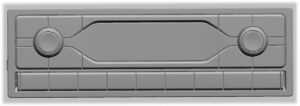
Note: Depending on your vehicle option package, the controls may look different from what you see here.
Read all Instructions for Connected Vehicle and Audio System User Guide
FORD E-350 2023 Accessories and Ford Protect User Guide
2023 FORD E-350 Accessories | Ford Protect Service Plan
Accessories
For a complete listing of the accessories that are available for your vehicle, please contact your authorized dealer or visit the online store web site:
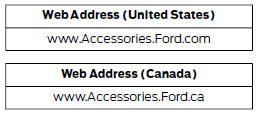
We will repair or replace any properly authorized dealer-installed Ford Original Accessory found to be defective in factory-supplied materials or workmanship during the warranty period, as well as any component damaged by the defective accessories.
We will warrant your Ford Original Accessory through the warranty that provides the greatest benefit:
- 24 months, unlimited mileage.
- The remainder of your new vehicle limited warranty.
Contact an authorized dealer for details and a copy of the warranty.
Ford Licensed Accessories are the accessory manufacturer’s designs. The manufacturer develops and therefore warrants Ford Licensed Accessories, and does not design or test these accessories to Ford Motor Company engineering requirements. Contact an authorized Ford dealer for the manufacturer’s limited warranty details, and request a copy of the Ford Licensed Accessories product limited warranty from the accessory manufacturer.
For maximum vehicle performance, keep the following information in mind when adding accessories or equipment to your vehicle:
- When adding accessories, equipment, passengers and luggage to your vehicle, do not exceed the total weight capacity of the vehicle or of the front or rear axle (GVWR or GAWR as indicated on the Safety Compliance Certification label). Ask an authorized dealer for specific weight information. The
- Federal Communications Commission (FCC) and Canadian Radio Telecommunications Commission (CRTC) regulate the use of mobile communications systems that are equipped with radio transmitters, for example, two-way radios, telephones and theft alarms. Any such equipment installed in your vehicle should comply with Federal Communications Commission (FCC) and Canadian Radio Telecommunications Commission
(CRTC) regulations and should be installed only by an authorized dealer. - An authorized dealer needs to install mobile communications systems. Improper installation may harm the operation of your vehicle, particularly if the manufacturer did not design the mobile communication system specifically for automotive use.
- If you or an authorized Ford dealer add any non-Ford electrical or electronic accessories or components to your vehicle, you may adversely affect battery performance and durability. In addition, you may also adversely affect the performance of other electrical systems in the vehicle.
AUXILIARY SWITCHES
For maximum vehicle performance, keep the following information in mind when adding accessories or equipment to your vehicle:
- When adding accessories, equipment, passengers, and luggage to your vehicle, do not exceed the total weight capacity of the vehicle or of the front or rear axle (GVWR or GAWR as indicated on the Safety Compliance Certification label). Ask an authorized dealer for specific weight information.
- The Federal Communications Commission (FCC) and Canadian Radio Telecommunications Commission (CRTC) regulate the use of mobile communications systems equipped with radio transmitters, for example, two-way radios, telephones, and theft alarms. Any such equipment installed in your vehicle should comply with Federal Communications Commission (FCC) and Canadian Radio Telecommunications Commission (CRTC) regulations and should be installed by an authorized dealer.
- An authorized dealer needs to install mobile communications systems. Improper installation may harm the operation of your vehicle, particularly if the manufacturer did not design the mobile communication system specifically for automotive use.
- If you or an authorized Ford dealer add any non-Ford electrical or electronic accessories or components to your vehicle, you may adversely affect battery performance and durability. In addition, you may also adversely affect the performance of other electrical systems in the vehicle.

The auxiliary switch option package provides four switches, mounted in the center of the instrument panel. These switches operate when the vehicle is running or from battery power, depending on the switchable PDB fuse locations #82 and #83. Ford recommends, however, that the engine remain running to maintain battery charge when using the auxiliary switches for extended periods of time or higher current draws. When switched on, the auxiliary switches provide 20 amps or 40 amps of electrical battery power for a variety of personal or commercial uses. The switches include the fuse and relay kit. This kit contains the required fuses and relays that an authorized technician needs to install into the power distribution box, located under the hood. Refer to the instruction sketch included in the kit. Contact an authorized dealer for service. Each switch includes a power lead (a blunt-cut and sealed wire) located in the underhood cowl shield above the engine block powertrain control module.
The power leads are coded as follows:
| Switch | Circuit Number | Wire Color | Fuse Amp Rating |
| AUX 1 | CAC05 | Yellow | 40A |
| AUX 2 | CAC06 | Green with Brown Trace | 40A |
| AUX 3 | CAC07 | Violet with Green Trace | 20A |
| AUX 4 | CAC08 | Brown | 20A |
Learn more about auxiliary switches by visitingfordpro.com/truckbbas/.
Up fitter Interface Module (If Equipped)
The Up fitter Interface Module (UIM) is an electronic control module that operates equipment (such as lift buckets, cranes, motors, salt spreaders, and snow plows) with external relays.
If you replace the module, it will require additional programming by the upfitter. Obtain this data directly from the upfitter company. The upfitter contact information is in the vehicle door opening. For more information on the Up fitter Interface Module and the auxiliary switches, contact your up fitter.
Read all Instructions for Accessories and Ford Protect User Guide
FORD E-350 2023 Scheduled Maintenance and Customer Information User Guide
2023 FORD E-350 Scheduled Maintenance | Complete Customer Information
GENERAL MAINTENANCE INFORMATION
Why Maintain Your Vehicle?
Carefully following the maintenance schedule helps protect against major repair expenses resulting from neglect or inadequate maintenance and may help to increase the value of your vehicle when you sell or trade it. Keep all receipts for completed maintenance with your vehicle. We have established regular maintenance intervals for your vehicle based upon rigorous testing. It is important that you have your vehicle serviced at the proper times. These intervals serve two purposes; one is to maintain the reliability of your vehicle and the second is to keep the cost of owning your vehicle down. It is your responsibility to have all scheduled maintenance performed and to make sure that the materials used meet the specifications identified in this owner’s manual. See Capacities and Specifications (page 224).
Failure to perform scheduled maintenance invalidates warranty coverage on parts affected by the lack of maintenance.
Why Maintain Your Vehicle at Your Dealership?
Factory-trained Technicians
Service technicians participate in extensive factory-sponsored certification training to help them become experts on the operation of your vehicle. Ask your dealership about the training and certification their technicians have received.
Genuine Ford and Moorcroft Replacement Parts
Dealerships stock Ford, Moorcroft and Ford-authorized branded re-manufactured replacement parts. These parts meet or exceed our specifications. Parts installed at your dealership carry a nationwide 24-month or unlimited mile (kilometer) parts and labor-limited warranty. If you do not use Ford-authorized parts they may not meet our specifications and depending on the part, it could affect emissions compliance.
Convenience
Many dealerships have extended evening and Saturday hours to make your service visit more convenient and they offer one-stop shopping. They can perform any services that are required on your vehicle, from general maintenance to collision repairs.
Note: Not all dealers have extended hours or body shops. Please contact your dealer for details.
Protecting Your Investment
Maintenance is an investment that pays dividends in the form of improved reliability, durability and resale value. To maintain the proper performance of your vehicle and its emission control systems, make sure you have scheduled maintenance performed at the designated intervals. Your vehicle is very sophisticated and built with multiple, complex, performance systems. Every manufacturer develops these systems using different specifications and performance features. That is why it is important to rely upon your dealership to properly diagnose and repair your vehicle.
Ford Motor Company has recommended maintenance intervals for various parts and component systems based on engineering testing. Ford Motor Company relies upon this testing to determine the most appropriate mileage for the replacement of oils and fluids to protect your vehicle at the lowest overall cost to you and recommends against maintenance schedules that deviate from the scheduled maintenance information. We strongly recommend the use of only genuine Ford, Motorcraft or Ford-authorized re-manufactured replacement parts engineered for your vehicle.
Additives and Chemicals
This owner’s manual and the Ford Workshop Manual list the recommended additives and chemicals for your vehicle. We do not recommend using chemicals or additives not approved by us as part of your vehicle’s normal maintenance. Please consult your warranty information.
Oils, Fluids, and Flushing
In many cases, fluid discoloration is a normal operating characteristic and, by itself, does not necessarily indicate a concern or that the fluid needs to be changed. However, a qualified expert, such as the factory-trained technicians at your dealership, should inspect discolored fluids that also show signs of overheating or foreign material contamination immediately.
Make sure to change your vehicle’s oils and fluids at the specified intervals or in conjunction with a repair. Flushing is a viable way to change fluid for many vehicle sub-systems during scheduled maintenance. It is critical that systems are flushed only with new fluid that is the same as that required to fill and operate the system or using a Ford-approved flushing chemical.
Owner Checks and Services
Make sure you perform the following basic maintenance checks and inspections every month or at six-month intervals.
| Check every month |
| Engine oil level. |
| Function of all interior and exterior lights. |
| Tires (including spare) for wear and proper pressure. |
| Windshield washer fluid level. |
| Check every six months |
| Battery connections. Clean if necessary. |
| Body and door drain holes for obstructions. Clean if necessary. |
| Cooling system fluid level and coolant strength. |
| Door weather strips for wear. Lubricate if necessary. |
| Check every six months |
| Hinges, latches and outside locks for proper operation. Lubricate if necessary. |
| Parking brake for proper operation. |
| Safety belts and seat latches for wear and function. |
| Safety warning lamps (brake, ABS, airbag and safety belt) for operation. |
| Washer spray and wiper operation. Clean or replace blades as necessary. |
Multi-point Inspection
In order to keep your vehicle running right, it is important to have the systems on your vehicle checked regularly. This can help identify potential issues and prevent major problems.
Read all Instructions for Scheduled Maintenance and Customer Information User Guide
FORD E-350 2023 Appendices User Guide
2023 FORD E-350 Appendices | License Agreement
Appendices
ELECTROMAGNETIC COMPATIBILITY
WARNING:
Do not place objects or mount equipment on or near the airbag cover, on the side of the front or rear seatbacks, or in areas that may come into contact with a deploying airbag. Failure to follow these instructions may increase the risk of personal injury in the event of a crash.
WARNING:
Do not fasten antenna cables to vehicle wiring, fuel pipes and brake pipes.
WARNING:
Keep antenna and power cables at least 4 in (10 cm) from any electronic modules and airbags.
Note: We test and certify your vehicle to meet electromagnetic compatibility legislation. It is your responsibility to make sure that any equipment an authorized dealer installs on your vehicle complies with applicable local legislation and other requirements. Installation of some aftermarket electronic devices could degrade the performance of vehicle functions, which use radio frequency signals such as broadcast radio receivers, tire pressure monitoring systems, push-button start, Bluetooth® connectivity or satellite navigation.
Note: Any radio frequency transmitter equipment in your vehicle (such as cellular telephones and amateur radio transmitters) must keep to the parameters in the following illustrations and table. We do not provide any other special provisions or conditions for installations or use.
Car/SUV

Van
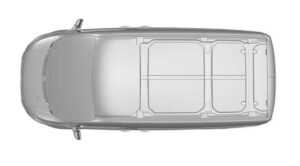
Truck
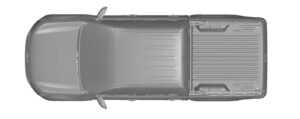
| Frequency Band MHz | Maximum Output Power Watt (Peak RMS) | Antenna Positions |
| 1-30 | 50 | 1 |
| 50-54 | 50 | 2, 3 |
| 68-88 | 50 | 2, 3 |
| 142-176 | 50 | 2, 3 |
| 380-512 | 50 | 2, 3 |
| 806-870 | 10 | 2, 3 |
END USER LICENSE AGREEMENT
SYNC End User License Agreement (EULA)
- You have acquired a device (“DEVICE”) that includes software licensed by Ford Motor Company and its affiliates
(“FORD MOTOR COMPANY”) from an affiliate of Microsoft Corporation
(“MS”) . Those installed software products of MS origin, as well as associated media, printed materials, and “online” or electronic documentation (“MS SOFTWARE”) are protected by international intellectual property laws and treaties. The MS SOFTWARE is licensed, not sold. All rights reserved. - The MS SOFTWARE may interface with and/or communicate with, or may be later upgraded to interface with and/or communicate with additional software and/or systems provided by FORD MOTOR COMPANY. The additional software and systems of FORD MOTOR COMPANY origin, as well as associated media, printed materials, and “online” or electronic documentation (“FORD SOFTWARE”) are protected by international intellectual property laws and treaties. The FORD SOFTWARE is licensed, not sold. All rights reserved.
- The MS SOFTWARE and/or FORD SOFTWARE may interface with and/or communicate with, or may be later upgraded to interface with and/or communicate with additional software and/or systems provided by third party software and service suppliers. The additional software and services of third party origin, as well as associated media, printed materials, and “online” or electronic documentation (“THIRD PARTY SOFTWARE”) are protected by international intellectual property laws and treaties. The THIRD PARTY SOFTWARE is licensed, not sold. All rights reserved.
- The MS SOFTWARE, FORD SOFTWARE and THIRD PARTY SOFTWARE hereinafter collectively and individually will be referred to as “SOFTWARE”.
IF YOU DO NOT AGREE TO THIS END USER LICENSE AGREEMENT (“EULA”) DO NOT USE THE DEVICE OR COPY THE SOFTWARE. ANY USE OF THE SOFTWARE,
Read all Instructions for Appendices User Guide
FAQ
The Ford E-350 is a full-size van produced by Ford. It is part of the Ford E-Series lineup and is commonly used for various commercial purposes, including cargo transport and passenger transportation.
The available configurations for the 2023 Ford E-350 may include cargo vans, passenger vans, and cutaway models, each designed for different purposes.
Engine options for the 2023 Ford E-350 may vary, but common engine options in previous models included gasoline and diesel engines, with various power outputs to suit different needs.
The maximum towing capacity of the 2023 Ford E-350 can depend on the specific engine and configuration. Towing capacities can vary widely but often range from 7,000 to 10,000 pounds or more.
Safety features can vary by trim level and options, but previous Ford E-350 models may offer features like airbags, stability control, rearview cameras, and more as part of their safety packages.
The passenger van version of the 2023 Ford E-350 can typically accommodate up to 12 passengers, but seating configurations may vary.
The available technology and infotainment features may vary, but Ford E-350 models often come equipped with features like touchscreen displays, navigation systems, and connectivity options such as Apple CarPlay and Android Auto.
The fuel economy of the 2023 Ford E-350 can vary depending on the engine and configuration. Gasoline engines generally have lower fuel efficiency compared to diesel engines.
The availability of four-wheel drive may depend on the specific trim level and configuration. Some E-350 models may offer rear-wheel drive, while others could have optional four-wheel drive.
Yes, the Ford E-350 can often be customized for various specialized purposes, including camper van conversions, shuttle buses, and more. Ford offers upfitter packages for this purpose.
The starting price of the 2023 Ford E-350 can vary depending on the trim level and configuration. It’s best to check with a Ford dealership or the official Ford website for the most up-to-date pricing information.
The payload capacity of the 2023 Ford E-350 cargo van can vary depending on factors such as the engine and configuration, but it can often exceed 3,000 pounds.
Common alternatives to the Ford E-350 for commercial use include the Chevrolet Express, Mercedes-Benz Sprinter, Ram ProMaster, and Nissan NV.
Some advanced driver-assistance features, such as lane-keeping assist and adaptive cruise control, may be available on certain trim levels of the 2023 Ford E-350.
For the most up-to-date and detailed information about the 2023 Ford E-350, including trim levels, options, and pricing, it’s recommended to visit the official Ford website or contact a local Ford dealership
Useful Link
2022 FORD Police Interceptor – Utility User Manualhttps://www.ford.com/support/owner-manuals/owner-manuals-sitemap/

